�
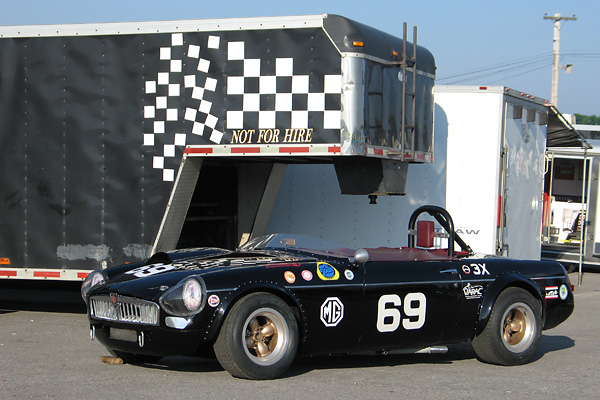
�
The Mike Adams / Al Pease Supercharged 1962 MGB Racecar
� � Owner: Mike Adams� City: Regina, Saskatchewan
� Model: 1962 MG MGB
� Engine: BMC 1.8L, supercharged
� Built by: Al Pease
� Restored by: Mike Adams�
�
The Dark Horse
��
In preparation for the 1963 Sebring twelve hour endurance race, MG and the BMC Competitions Department prepared�
three "Ecurie Safety Fast" works racecars.¹ Due to bad weather through the autumn months, BMC had only�
minimally tested and tuned these racecars in England. From MG's factory in Abingdon, the Sebring cars were shipped�
to an MG dealership in Hamilton Ontario. The dealership was challenged with continuing their preparation before�
the cars were transported to Florida. Along with the Sebring MGB's, the factory shipped crates of spare parts�
including specially hand-crafted aluminum body panels. Few MG enthusiasts know it, but these first famous MGB�
endurance racecars had a stable mate. A fourth MGB was shipped from Abingdon at about the same time and to the�
same dealership. �
�
A Canadian graphic artist named Al Pease had previously distinguished himself as an exceptional driver by�
piloting his Twin Cam MGA to many club-racing victories. Pease's driving skills were matched by his natural�
charisma. The MG factory quietly decided to sponsor Al Pease's racing team by providing a brand new MGB,�
free of charge.² The car shipped to Pease was never issued a VIN plate, and unlike the Sebring cars it never�
wore a registration number. Initially, it didn't wear any sponsorship decals either, because they were prohibited�
by the Canadian Automobile Sport Clubs (CASC). However, Al Pease's distinctive black MGB would eventually become�
the most famous, recognizable, and successful MG in the history of Canadian racing. �
�
�
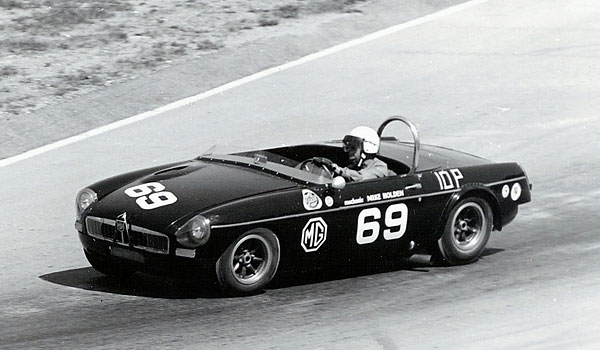
�
Mosport 1963: bulged hood, headlamp fairings, low profile windscreen, aerodynamic partial tonneau cover,
�
and rear fender flares to accommodate oversized tires on Cooper 8-spoke magnesium wheels.
�
Perhaps You Were Expecting Something More Subtle?
��
Those familiar with MG's "factory" MGB racecars of the 1960s will recall that they wore bright paint�
colors and looked basically stock. They almost always raced with factory-option hardtops installed.�
No hood bulges. No fender flares. They even retained production dashboards and vinyl covered interior trim�
panels. Inside the engine bay, S.U. carburetors³ were mounted on the same side of the engine as the exhaust,�
just like your mother's MGB. �
�
Comparing Al Pease's MGB to the factory's endurance racecars is like comparing a pirate ship to a�
Ship-of-the-Line. When Pease's team, "The Al Pease Racing Partnership" took delivery of their brand new�
black MGB, the first thing they did was aggressively cut away dead weight. In a series of detailed photos�
below, we show for example how front crossmember and suspension components were "swiss-cheesed". Pease was �
able to trade some of the MGB's original steel body panels for hand-crafted aluminum panels from the�
Sebring spare parts crates. (Exactly when body panels were upgraded is unclear; it may have been after�
several races.) Other aluminum parts were custom fabricated for the car by Pease and by a skilled�
fabricator in Toronto, Mike Lewis. The Al Pease MGB reached a fighting weight of under 1800 pounds, wet.�
�
�
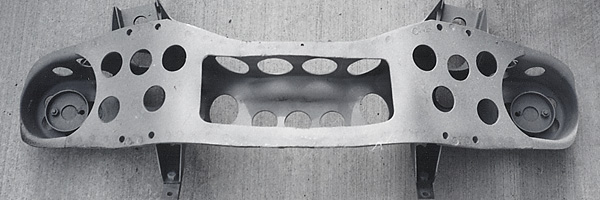
�
Al Pease's lightened front crossmember, as viewed from below during restoration.
�
Please support the sponsoring companies who make www.BritishRaceCar.com possible, including:
� �
 �
�
�
�
�
Traditionally, pirates didn't stop at throwing dead weight overboard. They also tried to optimize sails,�
rigging, and sometimes even the keel. Al Pease's close friend, Mike Holden, carefully rebuilt the MGB engine�
for racing. For the 1963 season, an HRG Derrington crossflow cylinder head and dual Weber 42DCOE carburetors�
were installed. (Besides adding horsepower, the aluminum cylinder head reduces weight by about eighteen pounds.)�
Al Pease hired a young former Derrington employee named Bob Egginton to custom port the cylinder head and to�
assist Holden with tuning. As Bob recalls, custom flat top pistons were sourced from a manufacturer in U.S.A.,�
and were mated to MGA Twin-Cam connecting rods which were preferred because they had solid small eyes instead of�
split eyes. "We always used Bosch distributors and coils as Al had some kind of deal with them and we thought�
their steel bodies were less likely to distort at high revs than the Lucas items. Likewise, we used Bosch plugs�
although these did give some problems as at the time they did not have the large range of heat variance of�
the available Champions." The engine was fitted with a Twin Cam oil pan, which was deeper than a stock MGB pan.�
A limited slip differential was installed in the rear axle.�
�
�
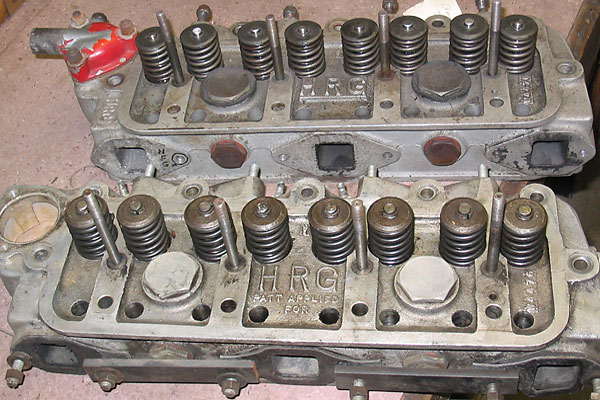
�
Two specially modified HRG-Derrington aluminum crossflow cylinder heads.
�
�
To slip through the water air with less resistance, the Pease team created a low profile Perspex windscreen�
and an aluminum partial tonneau cover. They also raided the BMC parts bin for Perspex headlamp fairings�
and a deep-section aluminum front valance. Pease fabricated and installed anti-tramp bars, long before they�
were fashionable. His black MGB demonstrates many similarly innovative construction and preparation details.�
�
Al Pease had an amazingly successful 1963 racing season. The supporting races held at Mosport during the Players 200�
weekend are a great example: in his MGB Pease won the "Production Sports Cars" group 15-lap race, and later that�
day he won the Sedan group race in his BMC-sponsored Austin Mini Cooper over a Pontiac GTO! (These "group" races�
included multiple classes, as determined by engine displacement. In both races Pease won outright over whole�
classes of competitors with larger engines.) At the conclusion of the year, Pease had racked up enough points in his MGB�
to be named The Canadian Racing Drivers Association's 1963 National Champion for Class 10. He also won CRDA's National�
Championship in the "Modified Sportscars Under 1600cc" class with his Lotus 23.�
�
�
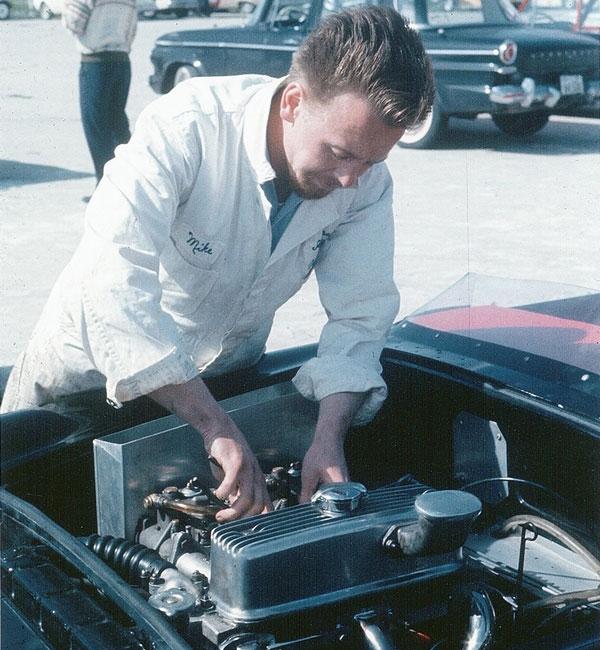
�
Mosport 1963: Mike Holden sets-up dual Webers 42DCOE carburetors on the HRG Derrington crossflow head.
�
�
Enjoying this article? www.BritishRaceCar.com is partially funded through generous support from readers like you!
�
To contribute to our operating budget, please click here and follow the instructions.
�
(Suggested contribution is twenty bucks per year. Feel free to give more!)�
�
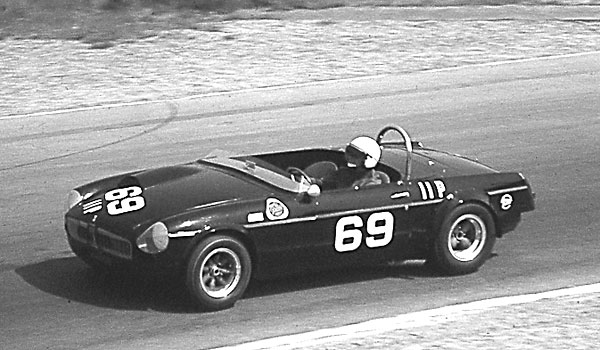
�
Mosport 1964: the modest hood bulge of 1963 has been replaced with a much larger air scoop. Earlier, small rear
�
fender flares have been relocated forward and replaced with larger rear flares, for wider wheels and tires.
�
Weight reduction efforts have apparently continued; notice that headlights have now been removed.
�
For 1964: Custom Supercharger and Wider Tires
��
In preparing for the 1964 racing season, The Al Pease Racing Partnership set its sights high. Their goal was�
to defeat the fastest "Production Sports Cars" in Canadian Automobile Sport Clubs competition, regardless of�
displacement. To achieve this goal, they took a page from the MG playbook of decades past: forced induction�
combined with exotic fuel blends in lieu of regular gasoline! �
�
To learn about superchargers, Al Pease made contact with engineering friends at Chrysler and apparently also at�
the Detroit Diesel division of General Motors, makers of the famous 6-71 supercharger. In particular, Pease and�
Holden worked closely with John Camden to construct and optimize a blower to the needs of a less-than-two-liter�
racing engine. Camden is believed to have originally created two prototype superchargers from cut-down 6-71 parts.�
One of Camden's prototypes was installed on Al Pease's MGB, via a custom cast aluminum intake manifold also�
created for the installation by John Camden. (The second supercharger was reportedly installed on a Volvo racecar�
by Werner Gudzus.) Camden would ultimately move to Phoenix to start his own aftermarket supercharger manufacturing�
business which remains in business under new ownership and management, to this day.�
�
Bob Egginton ported and reshaped the combustion cavities of a second Derrington cylinder head to lower the�
engine's static compression ratio as required for use with a supercharger. By mid-season, Egginton�
left the team to pursue more lucrative employment. Later in his career, Egginton would serve as Head�
of Production at John Surtees' Formula One team.�
�
�
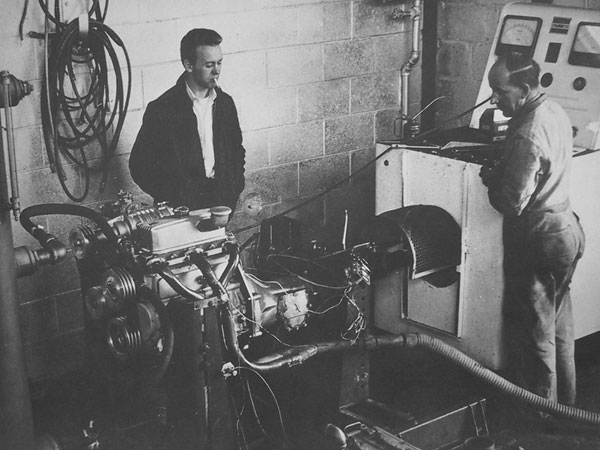
�
Dave Munroe of Nova Scotia discovered this vintage photo on the wall of a British car shop in Phoenix Arizona.
�
He arranged to photocopy it, front and back. A typed label appeared on the photo. It read:
�
"1964 271 H.P. MGB 5 MAIN BRG. - BUILT BY CHIEF MECHANIC MIKE HOLDEN"
�
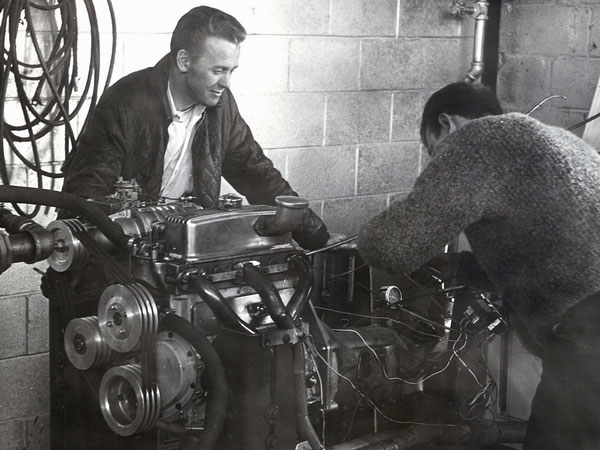
�
Mike Holden (left) and Bob Egginton (right) tune the newly supercharged engine on a borrowed dyno.
�
According to Bob's memory, the engine didn't excede 200hp on that first weekend. Bob also doesn't
�
recall running the Super-B on anything but Sunoco 5-star gasoline, whereas an exotic fuel cocktail has
�
been mentioned by several other sources. The 271hp figure (quoted above) would almost certainly require
�
a fuel with higher energy content than pump gas. The question is "Can an B-Series mill stand that strain?"
�
�
Mike Holden initially installed the supercharger on the engine with triple V-belts and with pulleys selected�
to turn the blower at twice the engine's crankshaft speed. At this ratio, the supercharger produced about 20�
p.s.i. of boost. In combination with the boost, the team would utilize a custom mixture of benzene, toluene and�
aviation fuel. Fuel was initially metered by a single-barrel Carter carburetor. Extensive dynamometer testing�
was needed to tune the supercharger installation. Bob Egginton helped Mike Holden interpret dyno results and�
tune accordingly. �
�
On account of its supercharger, Al Pease's MGB was given a new nickname: "Super-B".�
�
�
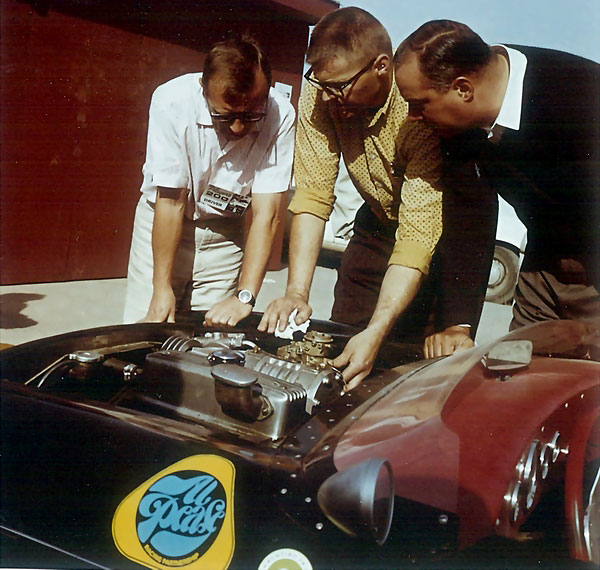
�
John Camden (center) helps Al Pease (left) dial in the Carter carburetor for the 1964 Player's 200 race.
�
�
Al Pease won dozens of trophies in 1964 on his way to a second consecutive Canadian Driving Championship title.�
Among his most notable appearances that year: Pease drove the Super-B to victory in the Class 10 sprint race�
that supplemented the Canadian Grand Prix. During the brand-new Mont Tremblant racetrack's inaugural race weekend,�
Pease won the 1300-2500cc race in his Super-B, and later that day he won the sedan class in his Austin�
Mini Cooper. In 1964's CASC/BEMC (British Empire Motor Club) Spring Trophy race, the Super-B finished first in�
class and third overall in the "Production Sports Cars Over 1600cc" race, behind a Corvette Sting Ray and an�
AC Cobra. Pease again entered supplemental races that supported the Players 200, finishing third in the�
"Production Sports Cars Over 1600cc" race (which was won by an AC Cobra) and second in the sedan class with his�
Mini Cooper (behind a Ford Mustang). Driving the Super-B, Pease easily won the Sundown Grand Prix of Endurance.�
(This is an annual night race at Mosport. In 1964, competitors raced from 7pm until 11pm.) That same weekend, Pease�
won the Production Sports Car sprint race in his MGB and the Sedan sprint race in his Mini. Pease wrapped up his�
1964 season with a Class 10 victory at the CASC/BEMC Indian Summer race. Through BMC's contingency awards program,�
Pease won a great deal of cash in 1964. He reinvested many of the cash awards into improvements to the Super-B. �
�
�
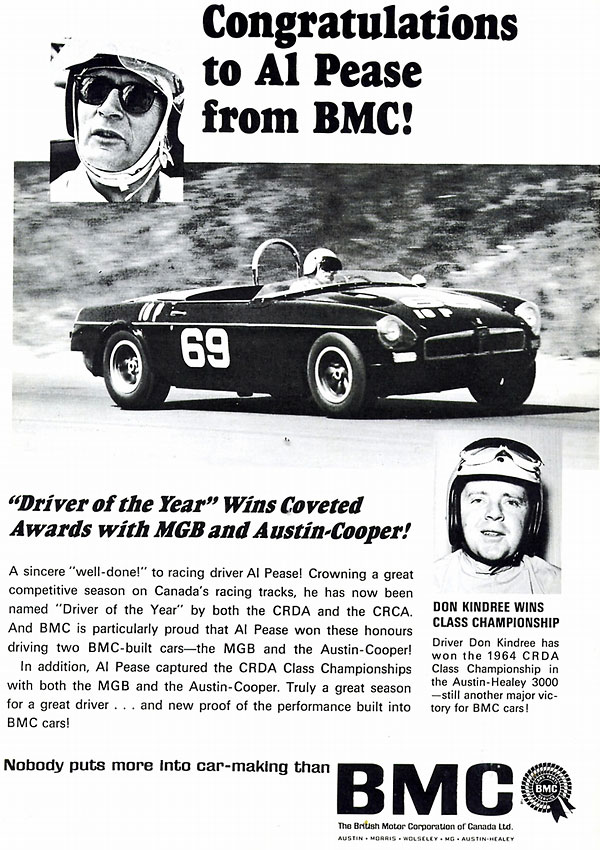
�
BMC congratulates Al Pease for taking CRDA and CRCA "Driver of the Year" titles in 1964.
�
(The Canadian Race Communications Association was an organization of race marshalls, corner workers, etc.)
�
Continued Success Through the Mid-Sixties
��
Although the initial supercharger installation worked well, actual racing experience provided information for�
continued development. Major improvements were made in two technical areas. Originally, three V-belts were�
specified to transfer power (~30 h.p.) from the crankshaft to the supercharger. However, rapid changes in engine�
speed - particularly in high r.p.m. ranges - tended to sweep the belts from their pulleys. By upgrading to a newly�
available Raybestos "Poly-V" 8-rib belt, the team found they could reliably utilize smaller pulleys, achieve a�
greater pulley ratio, and simultaneously utilize substantially lower belt tension. In a Raybestos trade journal�
advertisement, John Camden provided the following details: "Almost 50% manifold pressure increase added 10 mph�
to the MGB's top speed. National Canadian Production Car Champion Al Pease of Montreal won sixteen successive�
races in his MGB after the Poly-V Drive installation. And despite the total track time in these events, plus�
countless practice laps, the Poly-V 'K' belt shows virtually no wear." Even greater gains are rumored to have�
accompanied the team's switch from a one-barrel Carter carburetor to a two-barrel Holley carburetor. �
With these changes made, the Super-B was ready for continued success through 1965 and 1966.�
�
Throughout this period, Al Pease was poised to move up from racing his own cars to driving professionally for�
internationally known teams. However, the opportunities that presented themselves were with uncompetitive�
racecars. Pease co-drive a works Austin Healey Sprite in the 12 hour endurance race at Sebring with Donna�
Mae Mimms, but they retired with a broken axle after just nine laps. In 1965, Pease returned to Sebring to�
co-drive a works MGB (registration "DRX 256C"). Pease and Ricard qualified sixth in class and 50th�
overall, and they ultimately finished sixth in class and 32nd overall, but the top five positions in the�
Grand Touring 2000 class were all driving Porsche 904 GTS racecars, and four of these five purpose-built�
Porsche racecars were entered by the Porsche factory. �
�
Returning home and driving the Super-B, Pease dominated the Production Sports Cars support race of the June 4,�
1966, "Players 200" by defeating George Eaton in a Shelby Cobra and Horst Kroll in a Porsche 904 GTS, among many�
others. (Bruce McLaren won both heats of the USRRC feature race that weekend, in his Oldsmobile-powered McLaren M1B.) �
�
In fact, in 1966 Al Pease beat Comstock Racing's Ford V8-powered Cobras with his humble little four cylinder MGB�
on several occasions. This wasn't in the script. Before the season ended, Pease was advised by race officials that�
his supercharged MGB would no longer be allowed to compete in Production class racing. Pease decided to sell the�
Super-B and move on. His professional racing career would include three Formula One race starts (again,�
unfortunately seated in a very uncompetitive racecar) plus victories in both Formula 5000 (driving a Lola T140) and�
Formula A (driving Brabhams). Al Pease was inducted into the Canadian Motorsports Hall of Fame in 1998.�
�
�
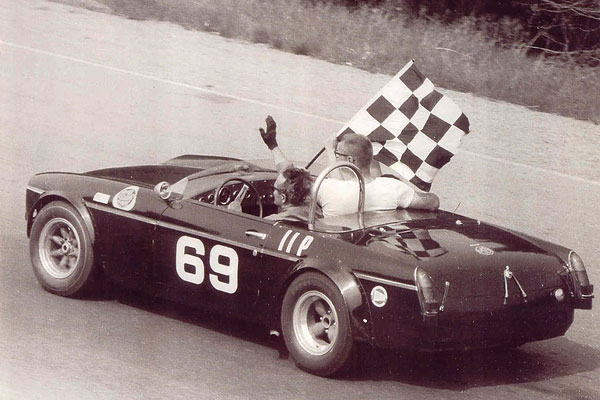
�
Pease drives a victory lap, following the 1964 Players 200. (Pease would repeat this victory in 1966.)
�
Al Pease drives, while John Camden and an unidentified flag-bearer ride along.
�
�
After Al Pease sold the Super-B, it passed through three owners who raced it successfully in western Canadian�
regional races without making significant changes to the car: Barrie Bratt of Regina Saskatchewan (1967-1968),�
Oran Genoway of Regina (1969), and Tom Atkinson (1970-~1973). Atkinson stored the Super-B from the mid-seventies�
until 1984 when it was sold to a young and inexperienced driver. In that driver's hands, it apparently completed�
about half of one race before the engine failed and the car went back into storage. The MGB ultimately moved from�
outdoor storage lot to outdoor storage lot, before ending up parked in a farmyard for about fifteen years.�
Mike Adams finally managed to convince the farmer/owner to part with the Super-B.�
�
�
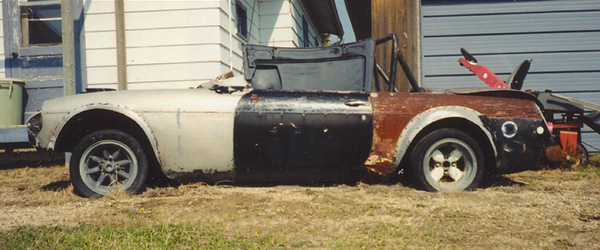
�
2001: Mike Adams purchased the Super-B in this neglected condition. (Notice that the front fenders
�
and the riveted-on fender flares are aluminum, although the door skins and rear fenders are steel.)
�
The Restoration
��
Restoration of the Super-B took Mike Adams about 5 years, working steadily but only part-time because of�
his career in commercial architecture. The pace of restoration was also affected by the historic significance�
of the car: Mike put a high priority on restoring the car to a very authentic presentation and to backing�
it up with extensive documentation. Mike is quick to point out that Al Pease was contacted quite early on,�
and that he's been a great resource for making the car correct. Pease provided early photos, and exchanged many�
letters and phone calls with Mike. �
�
When Mike purchased the Super-B, one critical component wasn't included; at some point during the car's�
longterm storage its original supercharger was stolen! Now, considering how specialized this supercharger�
was for its installation, it seems unlikely anyone but an MGB owner would be able to use it effectively.�
Furthermore, whoever removed the supercharger left behind its one-of-a-kind cast aluminum intake manifold.�
Mike hoped that he might find the blower collecting dust in someone's shop.�
�
As the rest of the restoration moved forward Mike decided to temporarily install dual Weber carburetors, just�
as Al Pease had done for the 1963 season. Other aspects of the car were also temporarily returned to 1963 spec.�
An old Bendix electric fuel pump fed gasoline from an original MGB steel fuel tank. Old fashioned breaker�
points and a condenser were installed in the distributor. In 2006, the newly restored Al Pease MGB returned to�
Mosport and ran a few demonstration laps. For this weekend, the Super-B wore its original Cooper 8-spoke�
magnesium wheels, with period Dunlop tires. Actually racing on fifty year old magnesium wheels isn't recommended�
because magnesium castings can degrade quite badly from the inside out and fail without warning. After this�
initial unveiling, Mike installed aluminum American Racing wheels of the same "Libre" model and sizes that�
Al Pease used later in the Super-B's career. �
�
While campaigning his MGB with twin Weber carbs, Mike continued searching for the original supercharger.�
When he ran out of leads, he searched for an appropriate replacement and ended up buying a second�
generation Camden blower off of eBay. This blower's housing required substantial machine work just to�
mate to the MGB's custom intake manifold. Mike managed to make it all fit together, and the Super-B�
raced in 2008 with its eBay blower. The set-up wasn't right though, and before long the motor threw�
a connecting rod. Mike removed the eBay blower and sent it to Camden in Washington State for measurements.�
From those measurements, they were able to build a special new supercharger that would better suit the�
Super-B and mate to the original manifold. There were just a few more details to work out, including a�
mid-season problem with snout seal retention. With the one-to-one ratio pulleys that are currently�
installed, the new blower should produce about 10psi of boost. Mike has recently swapped to a second�
vintage Derrington cylinder head with smaller combustion cavities, to achieve an increase in static�
compression ratio from about 8:1 to about 8.7:1. (This is in combination with custom fabricated pistons.)�
Instead of a high-test benzene/toluene/av-gas cocktail like Pease ran in the car's hey-day, Mike uses�
VP C-13 race gas. He plans to swap pulleys to increase boost as his confidence in the installation�
grows. Mike, a fearless champion Formula Ford racer and a competition driving instructor, notes that the�
Super-B is already "plenty fast enough to have great fun."�
�
Since 2006, Mike has raced the Super-B about four weekends each year. Since Mosport was Al Pease's home�
track and so much of the Super-B's history was made there, it's always particularly fun to return there.�
However, the drive from Regina Saskatchewan to Mosport (east of Toronto) takes over thirty hours!�
�
What class does the Super-B compete in? It depends on the racetrack and on who is sanctioning the�
race. At Mosport, the restored Super-B has raced three times in a special class for historically�
significant Canadian race cars. In Western Canada, with current closed-wheel grids, the Super-B�
runs in a catch-all Vintage class. On one occasion, Mike took the restored Super-B to a race weekend in�
Portland Oregon but wasn't allowed to race because the (apparently rather stodgy) local club wasn't�
able to figure out how to classify this amazingly well documented, historically noteworthy, and�
authentically restored MGB racecar. �
�
Mike is crewed by Gary Tholl and Gord Leach of Blurred Vision Racing.�
�
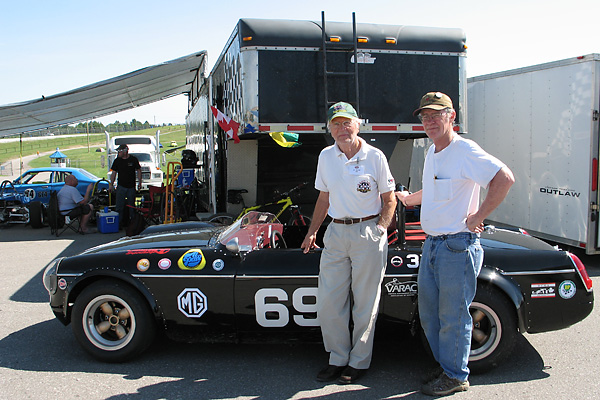
�
Al Pease and Mike Adams reunited at Mosport in June 2010.
�
(Mike's crew, Gord Leach and Gary Tholl of Blurred Vision Racing appear in the background.)
�
Features and Specifications
�| Engine: | �BMC 1.8L four cylinder engine, bored 0.040" over.�
(5 main bearing block.)�
Carrillo connecting rods.�
Custom JE pistons, with Total Seal rings.�
Kent Cam camshaft, tubular push-rods, standard tappets and rockers, and adjustable cam timing gear.�
HRG-Derrington 7-port crossflow aluminum cylinder head.�
Custom cast aluminum intake manifold.�
Custom Camden supercharger.�
Goodyear Gatorback Poly-V drive belt.�
Holley model 2300 (500cfm) two barrel carburetor.�
Moroso air cleaner.�
123ignition electronic distributor (with sixteen selectable advance curves.)�
Lucas Sport ignition coil.�
Cobalt spark plug wires.�
Custom deep sump, baffled oil pan.�
Morris Garage 21" 12-row oil cooler.�
Uprated oil pump.�
Remotely mounted oil filter.�
Aluminum transmission adapter plate.�
Lightened flywheel. | �
| Cooling: | �stock MGB brass/copper radiator, re-cored and with relocated ports.�
Custom fabricated aluminum venturi / air duct.�
Remote-mounted brass header tank (from a 1950's Ford). | �
| Exhaust: | �original Derrington long-center-branch tubular exhaust header (with a�
slight kink added to provide clearance to the steering shaft). �
No muffler. Pipe exits in front of driver-side rear wheel. | �
| Transmission: | �MGB 4-speed transmission with straight cut, close ratio gears.�
Borg & Beck clutch.�
Standard MGB driveshaft. | �
| Rear End: | �re-cambered MGB banjo axle.�
Limited slip differential.�
Various gear sets, depending on the track. | �
| Front Susp.: | �MGB racing-spec 600lb/in coil springs, cut for lower ride height.�
Armstrong lever-type shock absorbers.�
Lightened lower A-arms, spring pans, and front crossmember.�
Lowered steering rack.�
Modified uprights to suit non-stock brake caliper.�
MGB GT V8 bushings.�
3/4" anti-sway bar. | �
| Rear Susp.: | �stock MGB leafsprings, de-arched and with one leaf removed. �
Koni telescoping shock absorbers.�
Custom anti-tramp bars. | �
| Brakes: | �(master) later model (dual circuit) MGB master cyclinder. � (front) stock rotors (with lightening holes cut in bell section). Girling AR3 aluminum calipers. � (rear) MGB drum brakes with lightened backplates. | �
| Wheels/Tires: | �American Racing "Libre" aluminum wheels (13x8 front, 13x10 rear).�
Dunlop Racing tires ("Formula Ford" 165/580-13 CR82 front, 5.50-M-13/CR65/204 rear). | �
| Electrical: | �no charging system.�
MotoMaster Eliminator lead/acid battery.�
Nippondenso gear reduction starter.�
No headlights. | �
| Instruments: | �(left to right) �
ammeter (-60-60 Amperes). �
coolant temperature gauge (0-280F).�
Smiths tachometer (0-7000rpm).�
oil pressure (10-80psi), and�
boost gauge (0-20psi) gauges.�
(Note: the ammeter isn't hooked up; it's just there to fill the hole.) | �
�
| Fuel System: | �ATL 8 gallon fuel cell. �
Holley "blue" (9-14psi) fuel pump. �
Holley adjustable fuel pressure regulator. | �
| Safety Eqmt: | �Pyrotect 6-point cam-lok safety harness.�
Amerex handheld fire extinguisher.�
Raydyot mirrors. | �
| Misc.: | �original MG-supplied aluminum front fenders, hood, and trunk lid.�
Original custom fabricated aluminum fender flares (see below for explanation).�
Custom fabricated aluminum inner door skins (new) and door hinges (original).�
Custom fabricated aluminum bucket seats (one original and one new).�
Original custom fabricated aluminum front valance�
Fiberglas replacement rear valance.�
Replacement aluminum half-tonneau cover (which hides most of the upgraded roll hoop structure).�
Custom Perspex (acrylic) windshield.�
Sebring-style acrylic headlight fairings.�
Grant "Challenger" steering wheel. | �
| Weight: | �under 1800 pounds. | �
| Racing Class: | �various. (See above.) | �
| Completed: | �early 1963, and the restoration was completed in 2006.�
The car has participated in about four race meets each year since its restoration. | �
Engine Installation
��
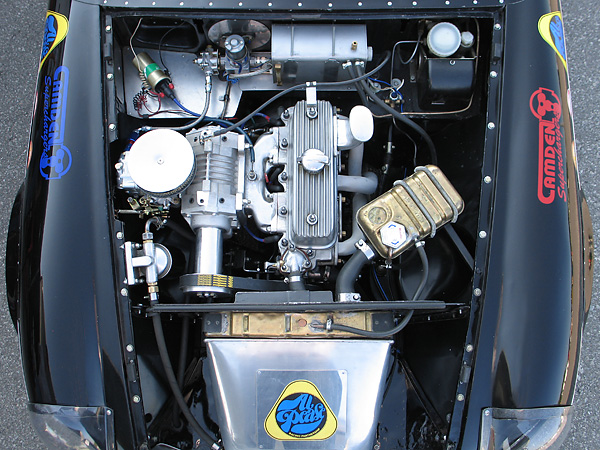
�
Al Pease's Chief Mechanic, Mike Holden, was always given credit for the engine's exceptional performance.
�
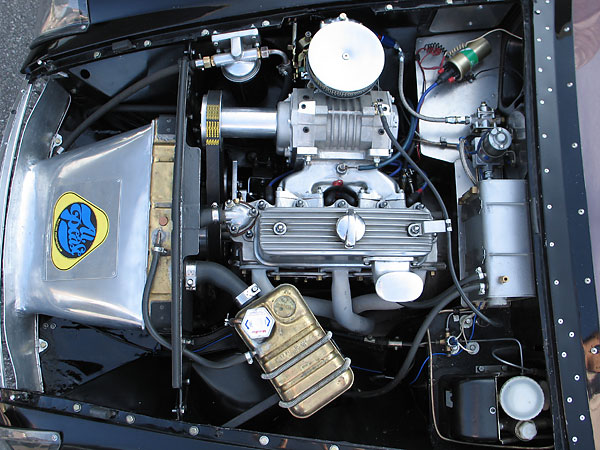
�
Before restoration, while the Al Pease MGB languished in various storage lots its original supercharger
�
was stolen. Researching and finding a replacement supercharger was one of the most challenging aspects
�
of the restoration.
�
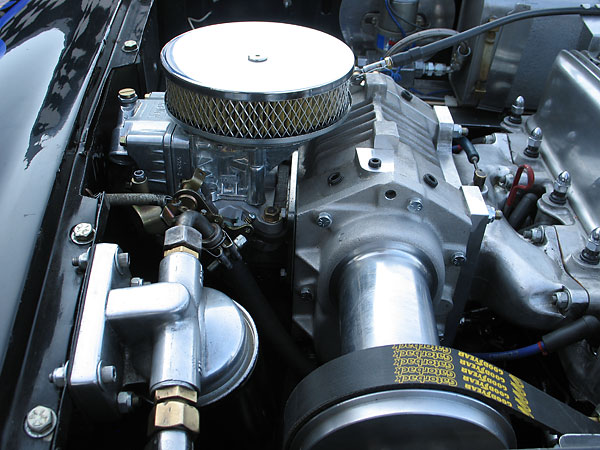
�
John Camden of Camden Superchargers had worked with Al Pease to develop the original Supercharger.
�
Although that fine old company was sold and relocated to Washington State, they're still in business.
�
A new Camden 5" supercharger was purchased and custom modified for the MGB's restoration.
�
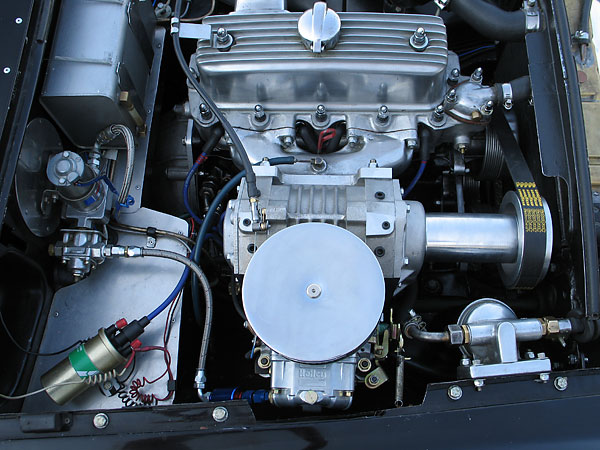
�
Originally, the Camden supercharger was installed with a smaller pulley and spun at twice the engine speed.
�
Back in the day, Camden had problems with conventional fan belts slipping and flying off so they worked
�
with Raybestos-Manhatten in a pioneering application of the "Poly-V" / serpentine fan belt. Raybestos
�
then prominently featured the Al Pease MGB in trade journal ads for their Poly-V product line.
�
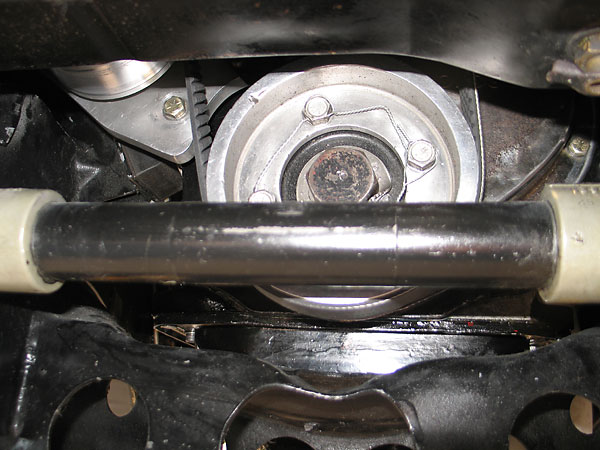
�
5.25" 8-rib aluminum crankshaft pulley, to suit the serpentine fan belt.
�
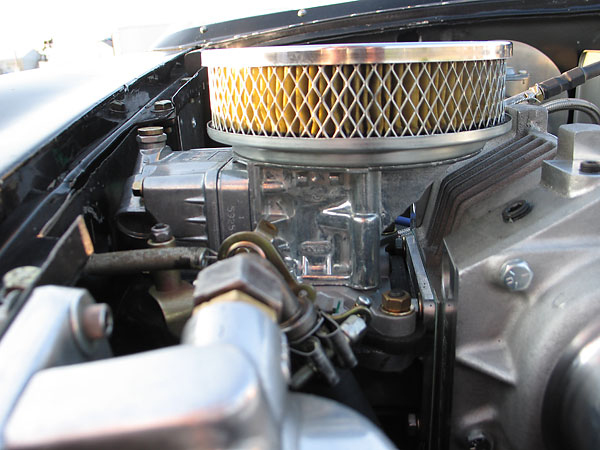
�
Moroso air cleaner, viewed from front.
�
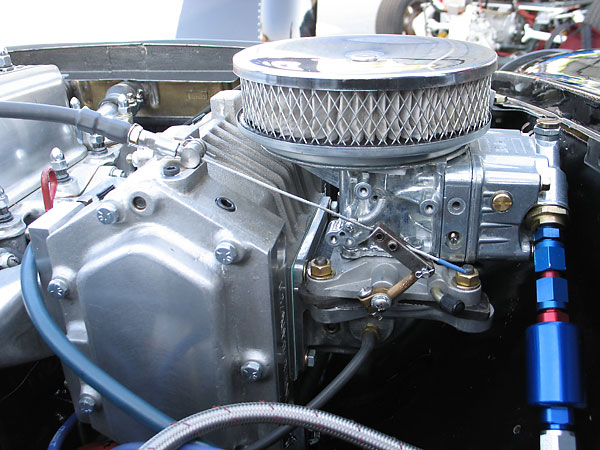
�
Holley model 2300 (500cfm) two barrel carburetor, viewed from rear.
�
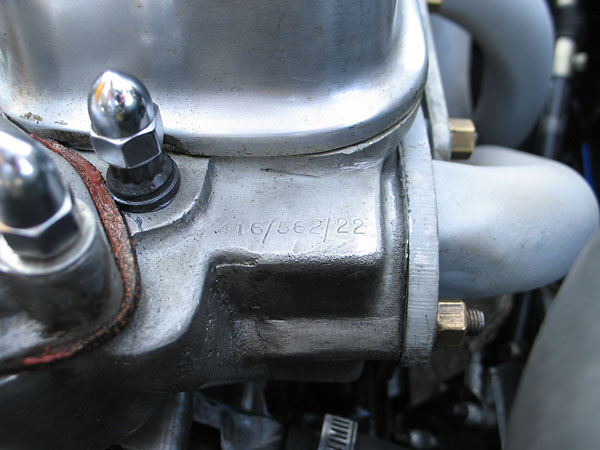
�
HRG-Derrington 7-port crossflow aluminum cylinder head, stamped 416/562/22.
�
(In other words: serial number 416, produced in May 1962, model variant 22.)
�
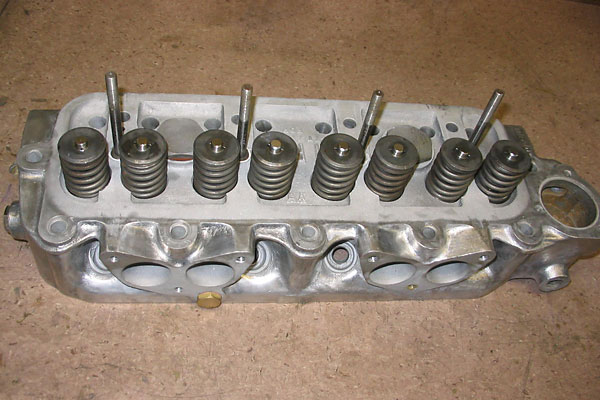
�
Two HRG-Derrington crossflow cylinder heads were specially prepared for Al Pease's MGB:
�
one for normally aspirated use and one for use with a supercharger.
�
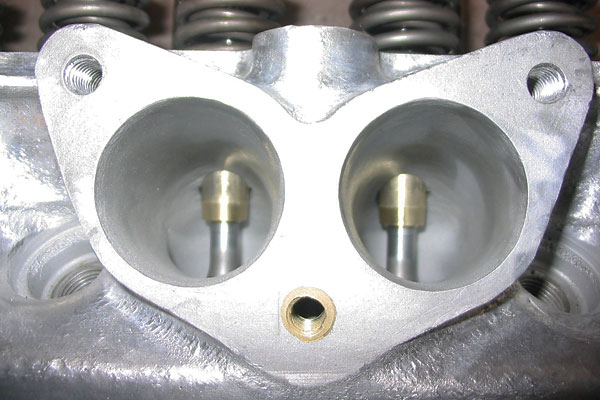
�
In both cases, the intake ports were enlarged and reshaped for improved flow (as shown here).
�
Combustion chambers of the supercharged version were enlarged too, but no photo of that is available.
�
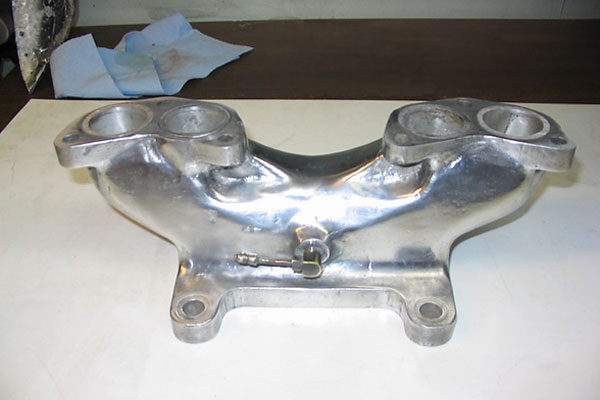
�
John Camden designed this intake manifold and had it sand-cast for the Super-B.
�
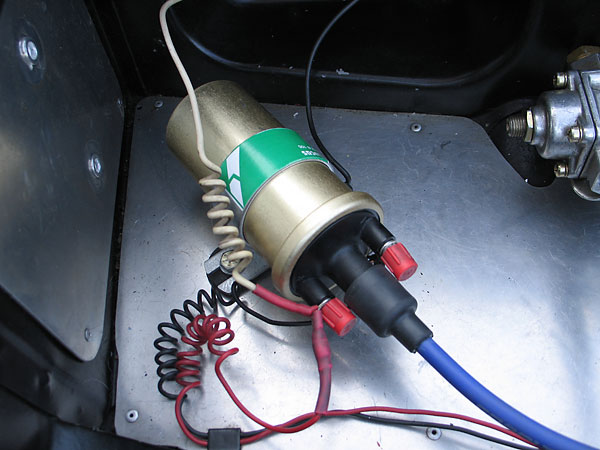
�
Lucas Sport ignition coil.
�
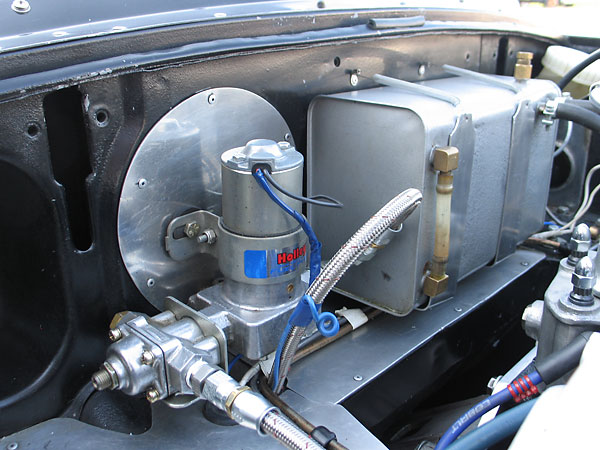
�
Holley "Blue" (9-14psi) fuel pump. Holley adjustable fuel pressure regulator.
�
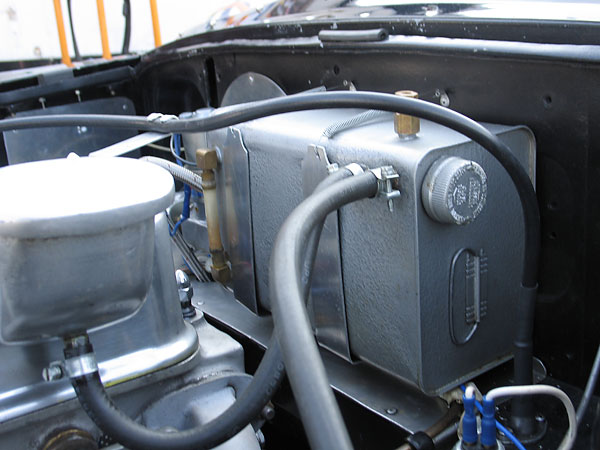
�
Breather tank fashioned from an old one gallon turpentine can.
�
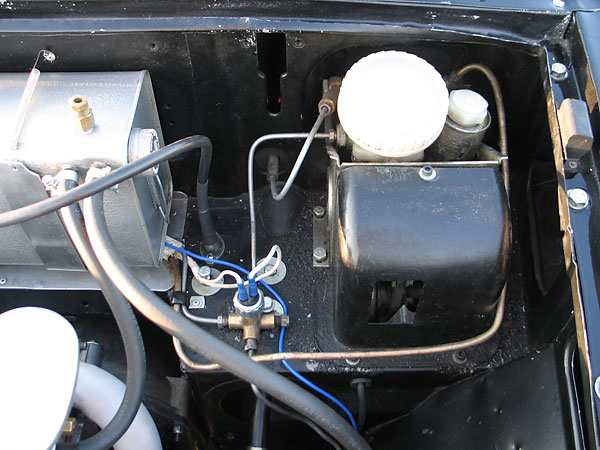
�
This is an MGB master cylinder, but it's from a later era. (Dual circuit brake systems were
�
mandated by the United States' Safety Act of 1967.)
�
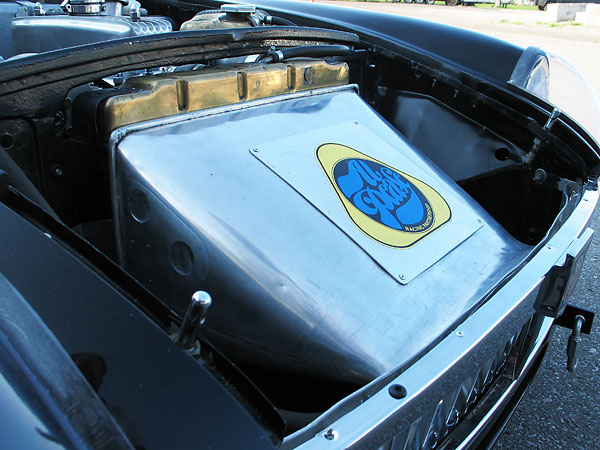
�
Streamlining airflow into the radiator core is one of the most basic and effective ways to
�
enhance a car's engine cooling capacity. This ductwork also keeps air from passing around
�
or over top of the radiator.
�
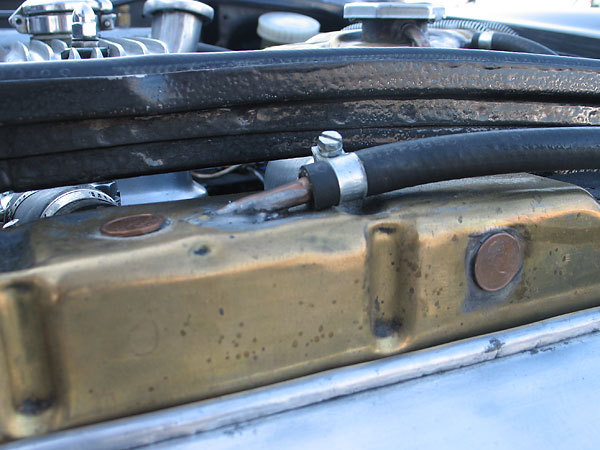
�
(Pennies were soldered onto the radiator during restoration to repair small holes.)
�
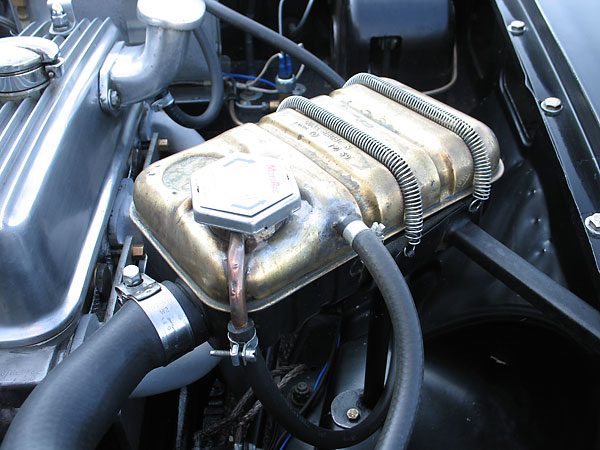
�
Long Manufacturing Ltd. brass header tank. (Note date code: 12/59.)
�
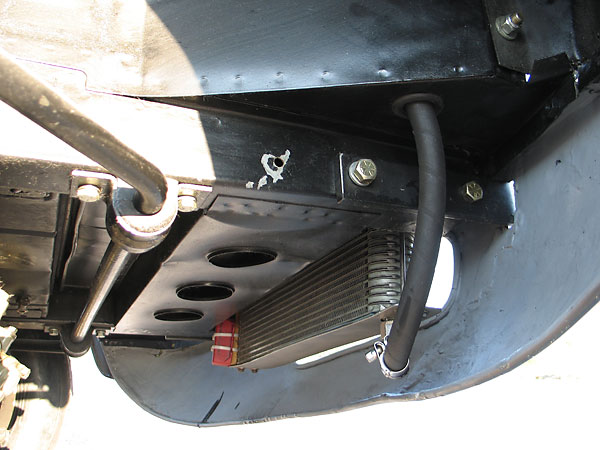
�
It's believed that this Morris Garage oil cooler has probably been used on the Al Pease MGB since its
�
first race back in 1963. It's twenty-one inches long and has twelve rows and a baffled header tank. Oil
�
enters at the top, flows across the top of the cores, back across the bottom cores, and out the same
�
header tank at the bottom. Mike says that despite a long search, he hasn't been able to find a spare.
�
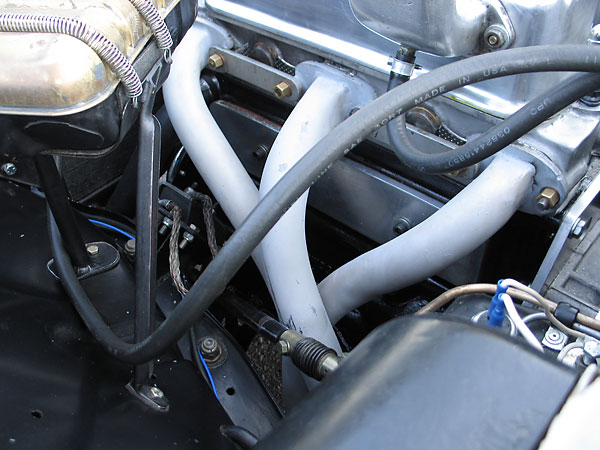
�
One of the original selling points of HRG crossflow cylinder heads was that they were compatible
�
with standard MG exhaust manifolds or popular aftermarket headers.
�
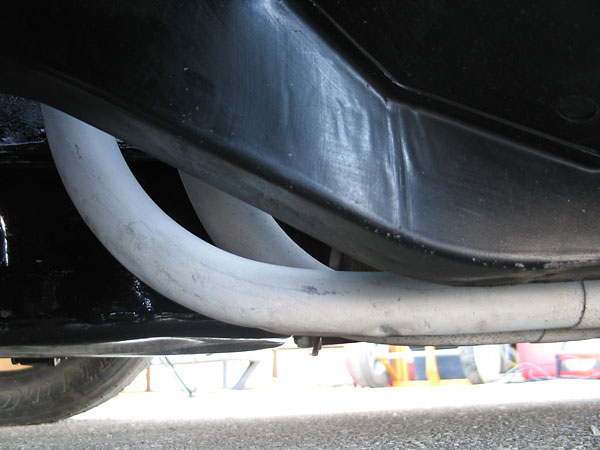
�
Derrington is believed to have also made these vintage long center branch headers.
�
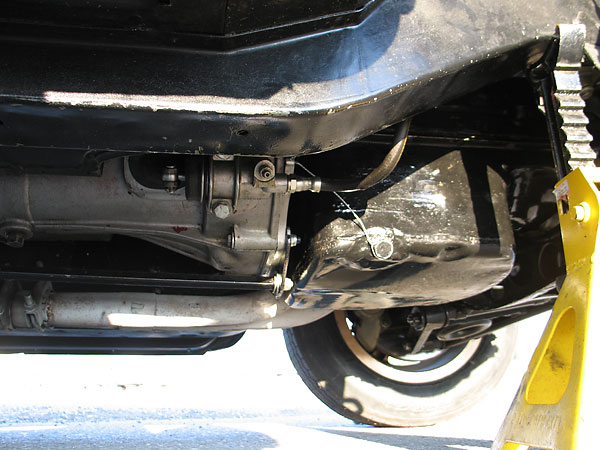
�
Originally Al Pease used an MGA Twin Cam oil pan for its deeper sump.
�
At some point it was replaced by this custom modified MGB oil pan.
�
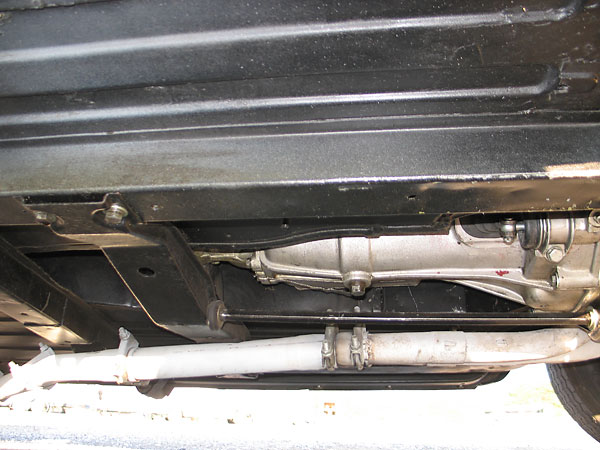
�
A stay rod keeps the engine from moving rearward.
�
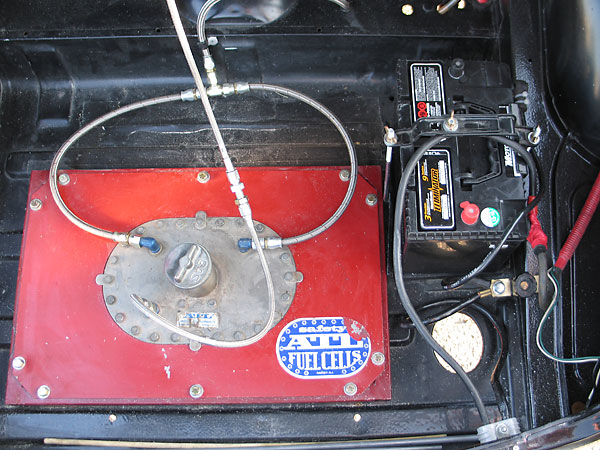
�
Nowadays, this ATL eight gallon fuel cell usually contains VP C-13 race gas. Back in the sixties,
�
the Super-B carried dual MGB Mk1 fuel tanks one-atop-the-other just like the factory's Sebring
�
endurance race cars. Through the mid-sixties Al Pease burned custom mixtures of benzene, toluene,
�
and aviation fuel, which allowed him to get the most from higher supercharger boost pressures.
�
Front Suspension
��
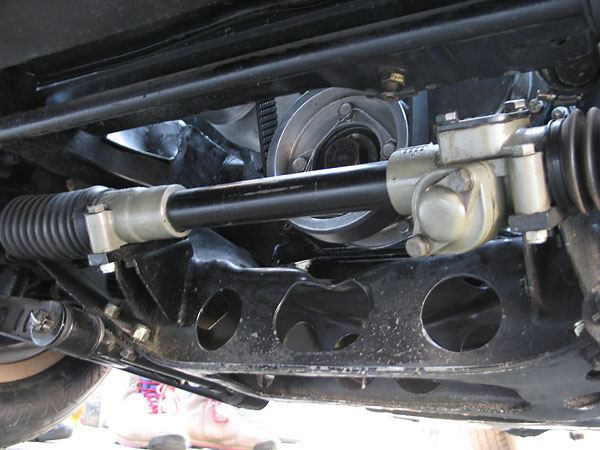
�
The Al Pease MGB has survived and won countless races with this radically lightened front crossmember.
�
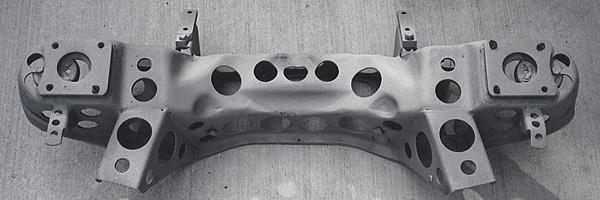
�
During the restoration, Mike Adams inspected every lightening hole in the crossmember.
�
None of the holes showed any significant distortion.
�
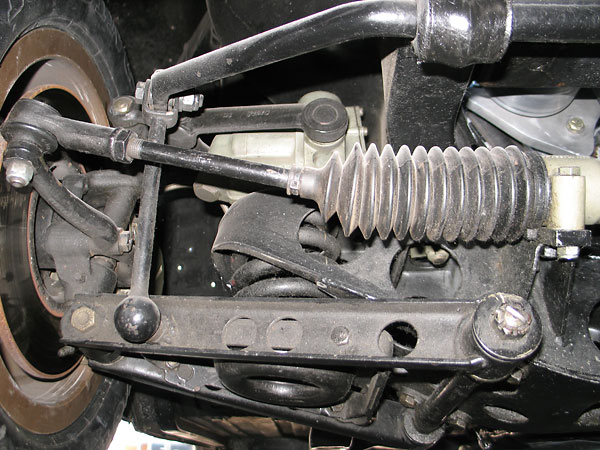
�
3/4" anti-sway bar.
�
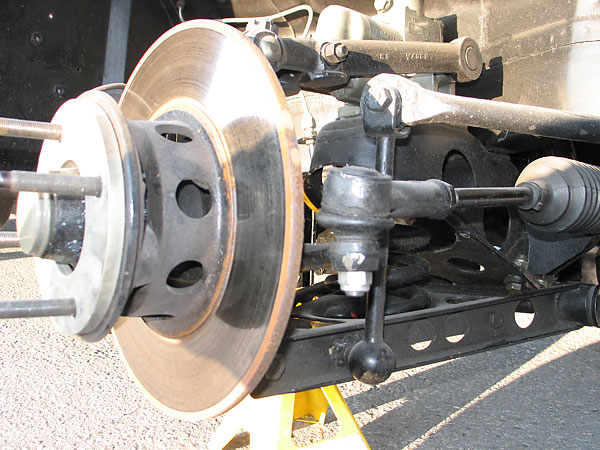
�
Al Pease's team put a lot of work into lightening the front suspension!
�
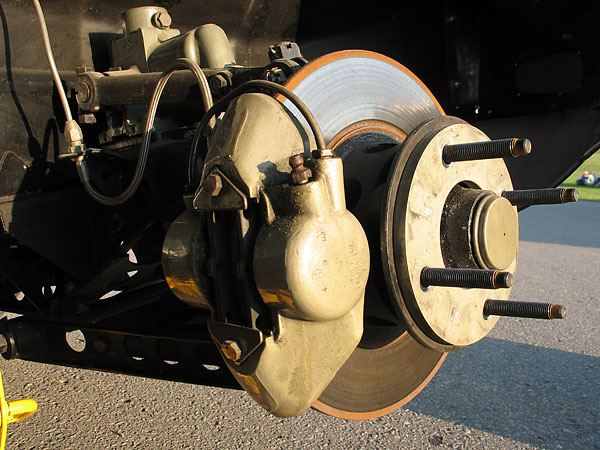
�
Girling model AR3 aluminum calipers (date stamped "4 9 63".)
�
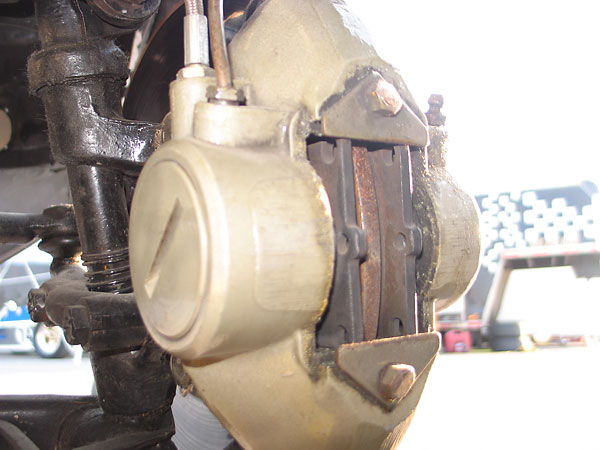
�
The front uprights were slightly modified to support the Girling brake calipers, but they
�
weren't modified to lower the car. (In other words, "dropped spindles" aren't installed.)
�
�
Rear Suspension
��
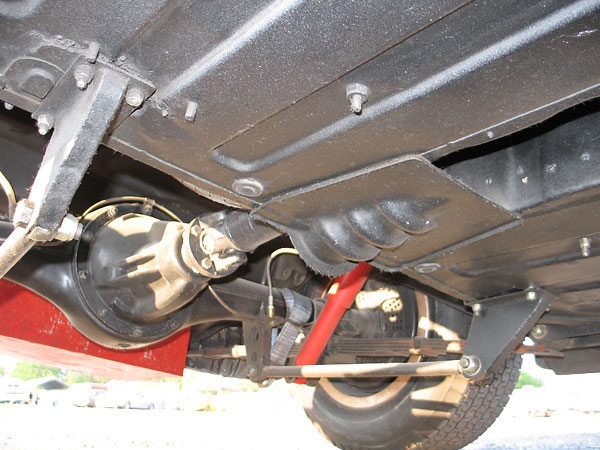
�
These anti-tramp bars were fabricated and installed by Al Pease in 1963.
�
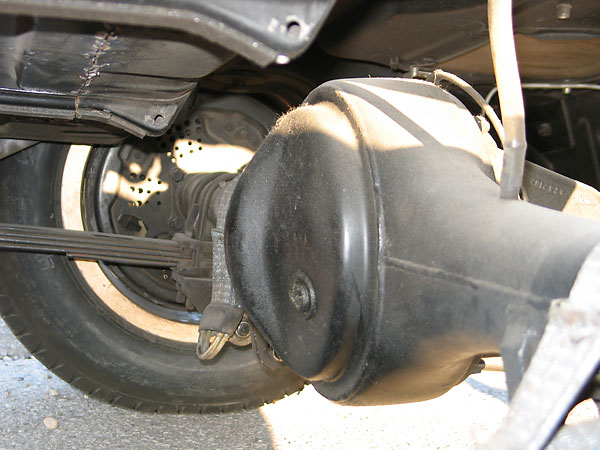
�
MGB drum brakes with lightened backplates.
�
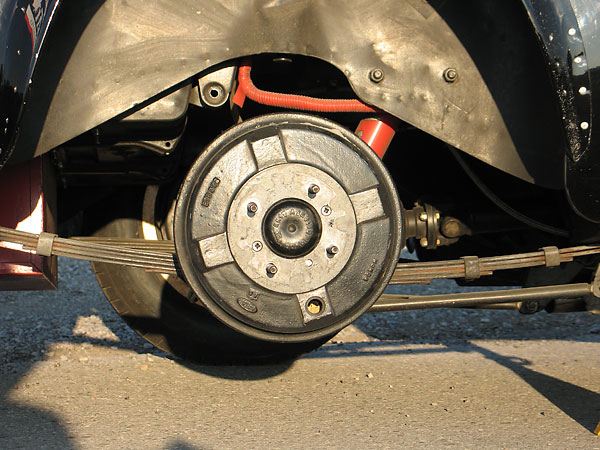
�
Stock MGB leafsprings, de-arched and with one leaf removed.
�
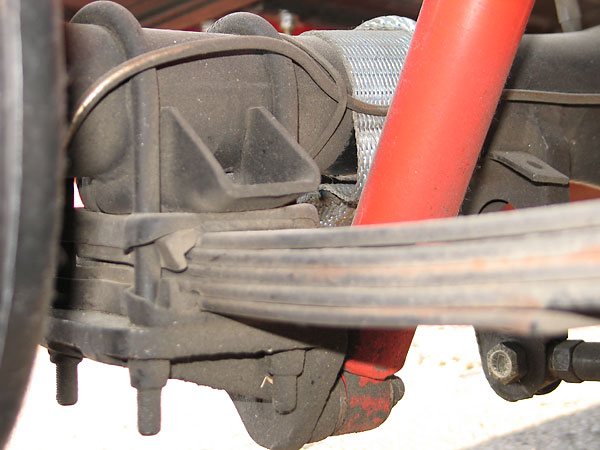
�
Al Pease fitted Koni shocks quite early on, to achieve a weight savings of about three pounds.
�
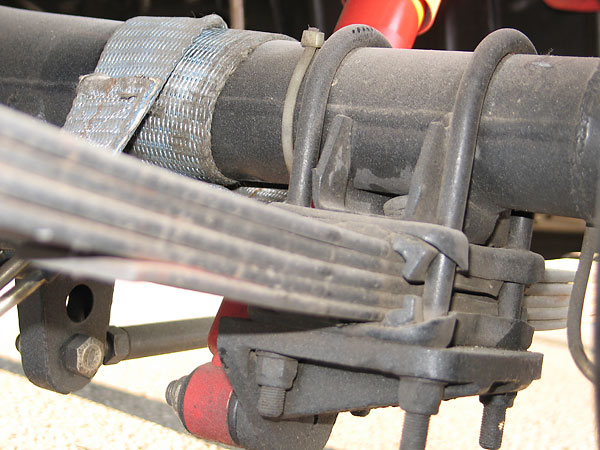
�
Pease also lowered his MGB about 1.5" by removing one leaf and de-arching the remaining leafs.
�
�
Interior / Roll Structure / Etc.
��
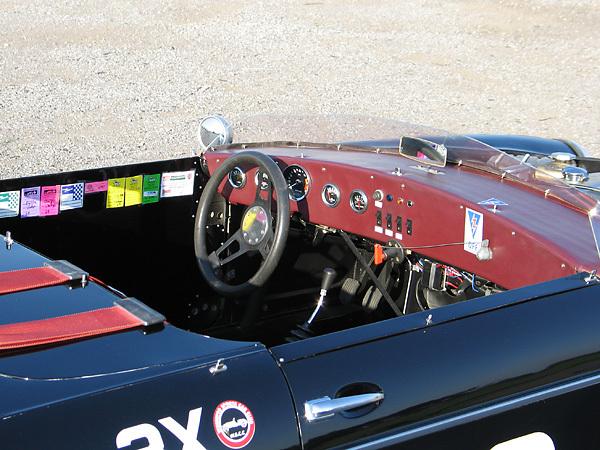
�
Both interior door panels were custom formed out of aluminum.
�
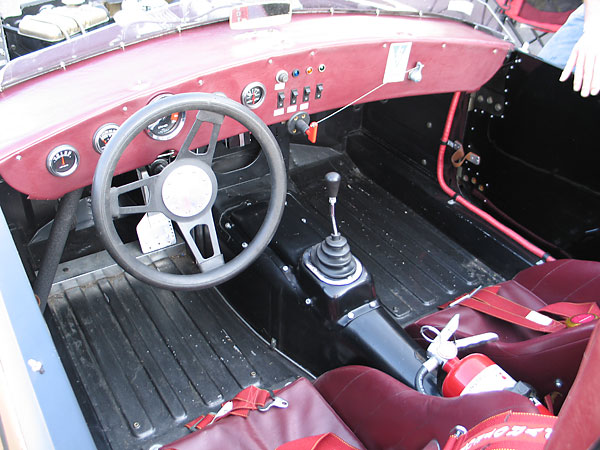
�
Custom fabricated aluminum bucket seats (one original and one new).
�
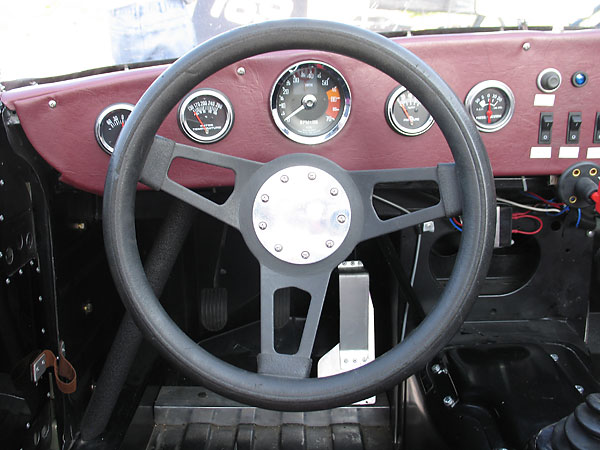
�
Grant "Challenger" steering wheel.
�
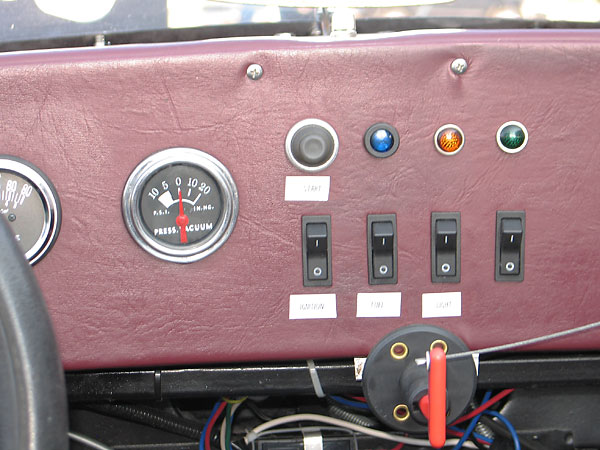
�
Start pushbuttom. Left-to-right: "Ignition", "Fuel", "Light" and electric fan (used in the pre-grid only) rocker switches.
�
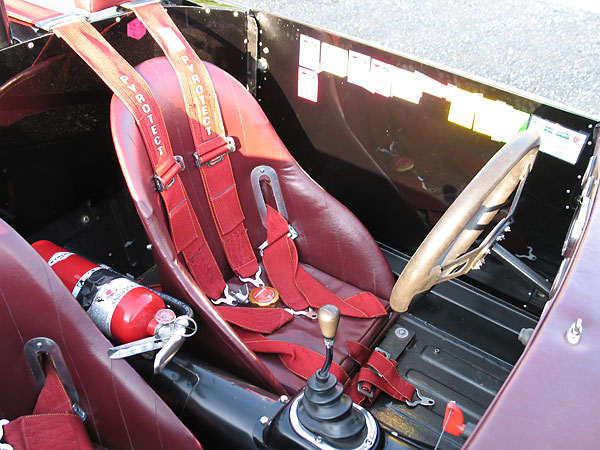
�
Pyrotect 6-point safety harness.
�
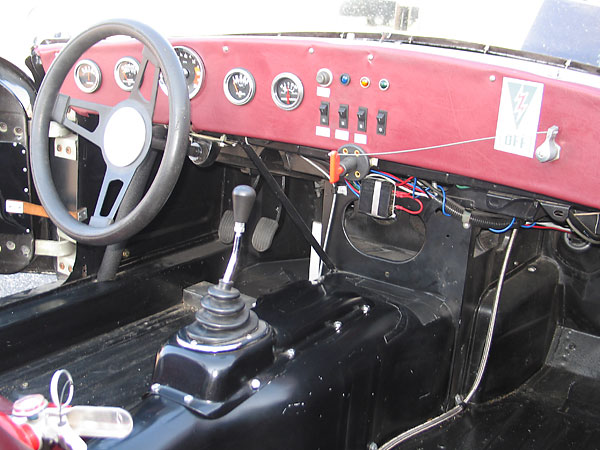
�
The original master cut-off switch was too far away for Mike to reach while strapped in, so a simple
�
slap cable extension (to a dummy switch) was added.
�
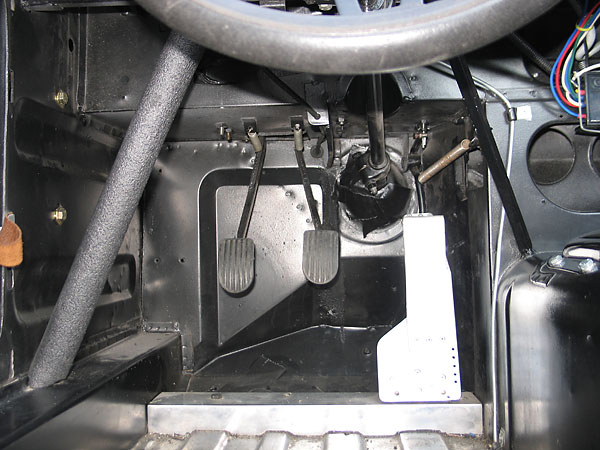
�
A heel-bar helps the driver keep his feet securely in position relative to the pedals.
�
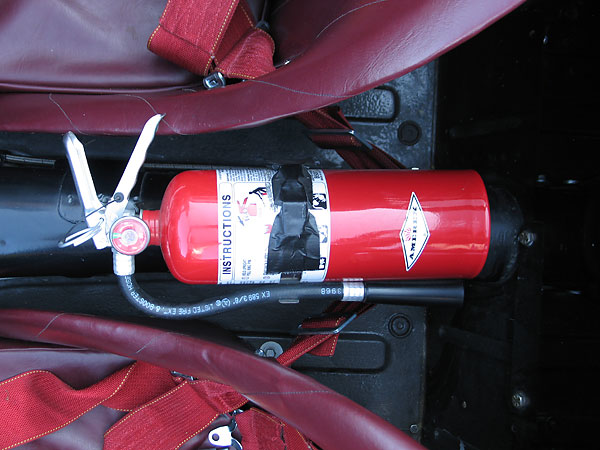
�
Amerex handheld fire extinguisher.
�
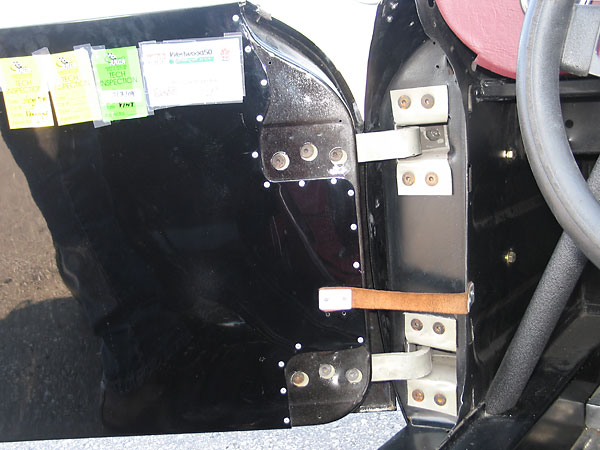
�
These lightweight aluminum door hinges were among the many special parts fabricated by Al Pease.
�
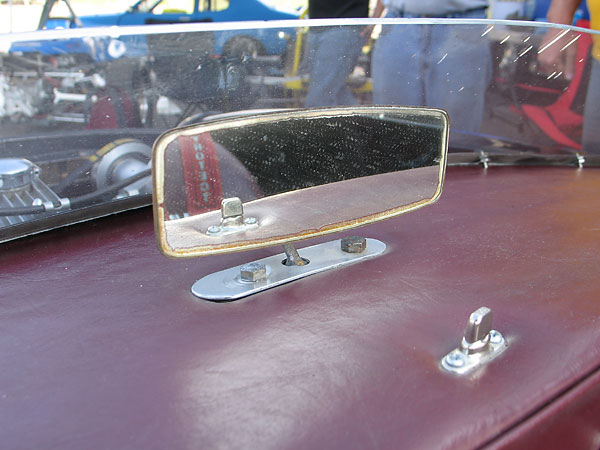
�
Rear view mirror.
�
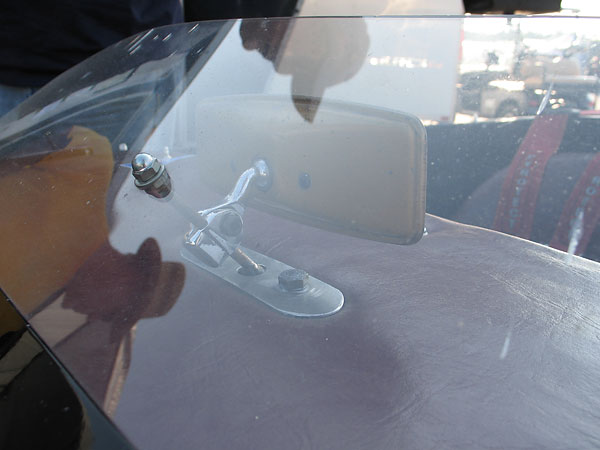
�
Rear view mirror mounting bracketry.
�
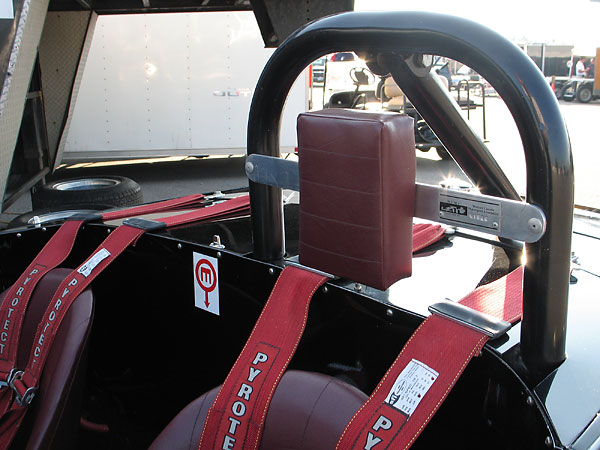
�
From the beginning, the Al Pease MGB featured a small single roll hoop and also an
�
aluminum partial tonneau cover. The rearward roll hoop brace is a modern addition.
�
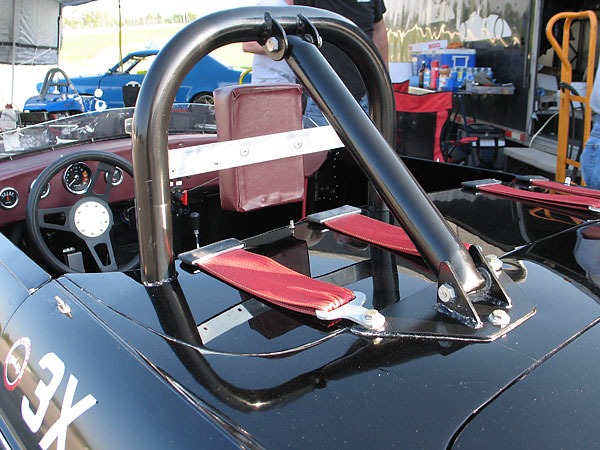
�
Varying from 1963 construction, Mike Adams had a much stronger tubular safety structure
�
installed. It's hidden very discretely under the aluminum partial tonneau cover.
�
�
Exterior
��
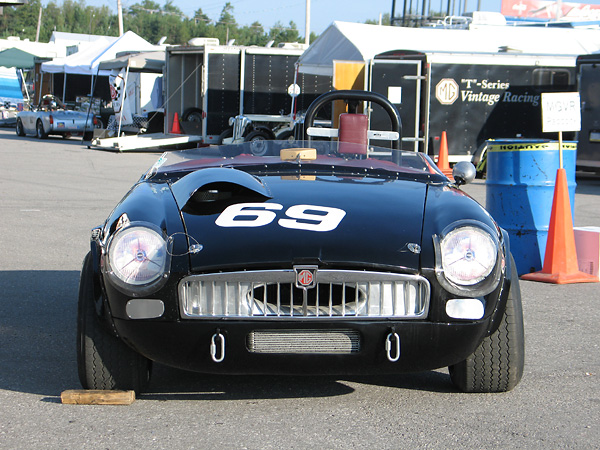
�
Removed slats from the front grille are a trademark feature, as is the aluminum "venturi" radiator air duct.
�
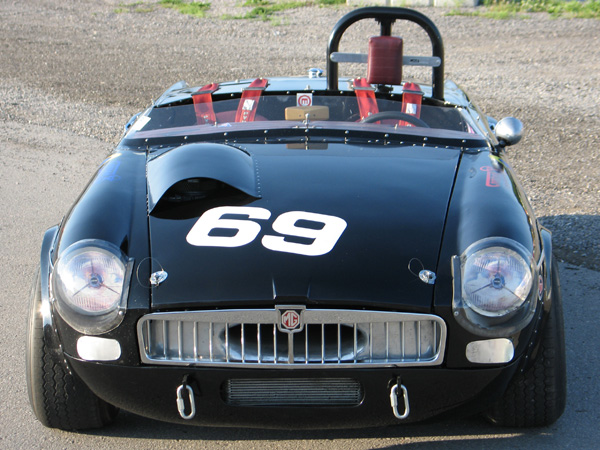
�
This carefully-straightened aluminum front valance is believed original to the Al Pease Racing Partnership years.
�
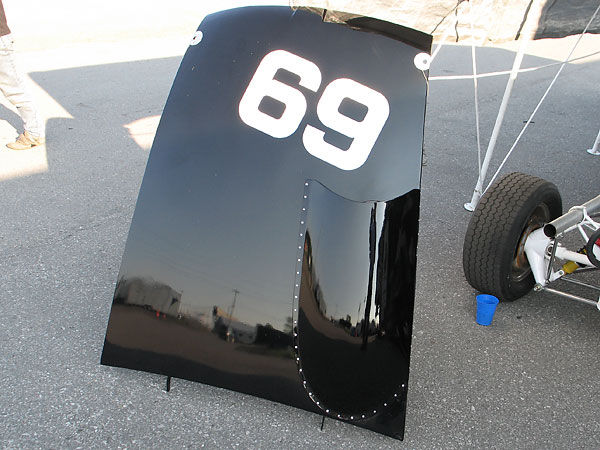
�
For the restoration, Al Pease leant Mike Adams the original cardboard pattern for cutting the car's number (69).
�
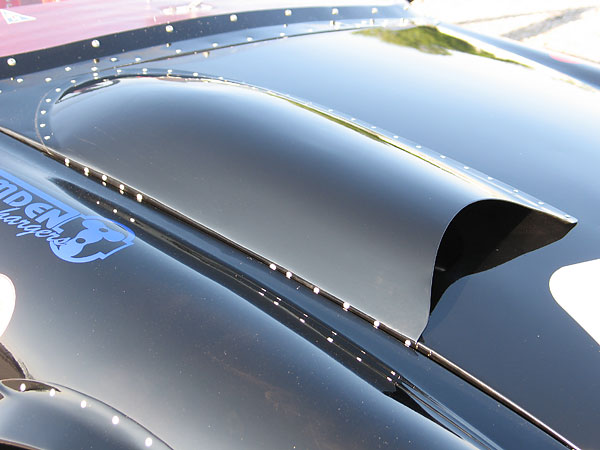
�
For 1963, dual Weber DCOE carburetors were installed on a Derrington crossflow cylinder head.
�
To accomodate the Webers, Al Pease's MGB originally sported a performance blister.
�
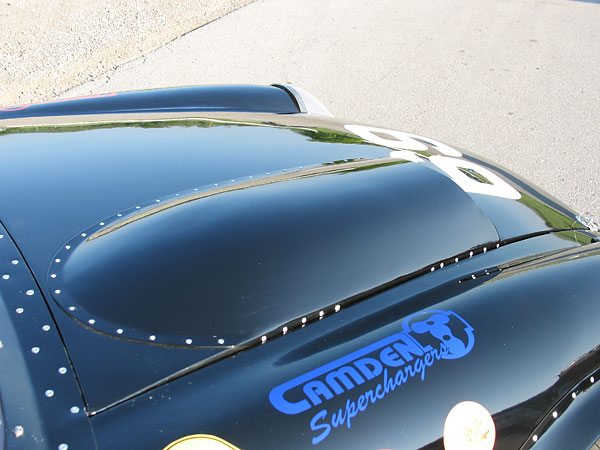
�
For 1964, to accomodate a supercharger the original performance blister was replaced with an air scoop.
�
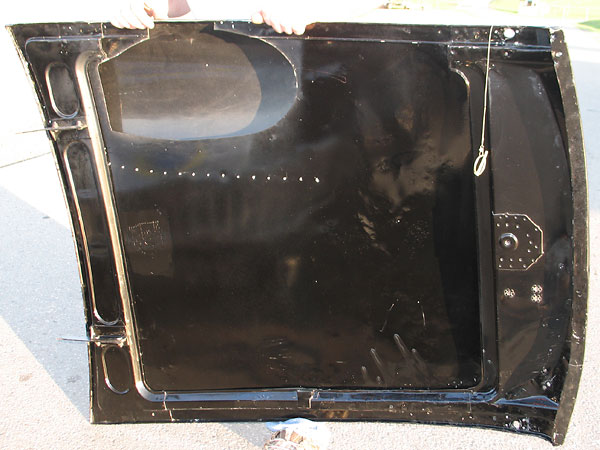
�
The hood scoop was custom formed out of aluminum sheetmetal.
�
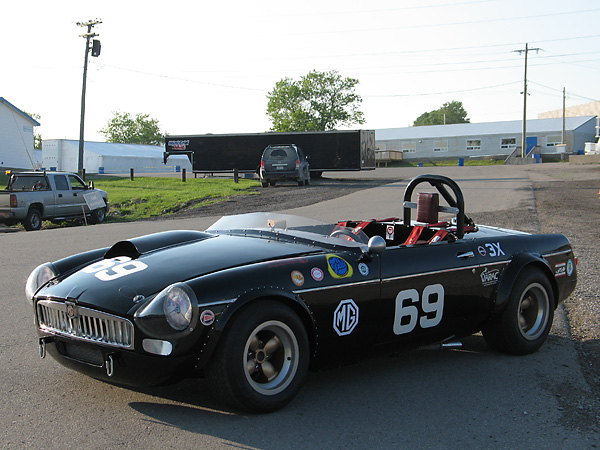
�
Al Pease's MGB had rear fender flares from its first race in 1963.
�
Front flares were added for the 1964 season.
�
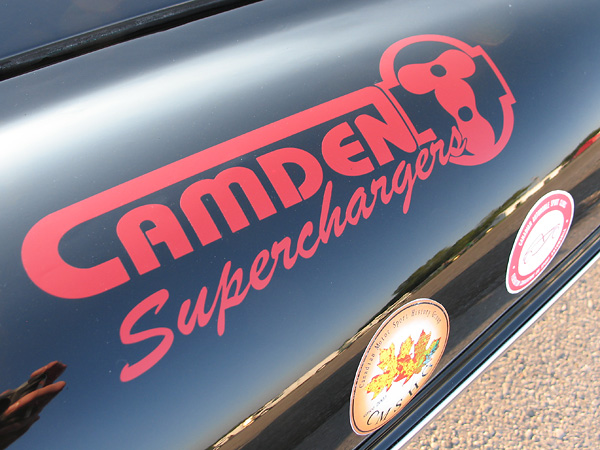
�
Camden Superchargers decal.
�
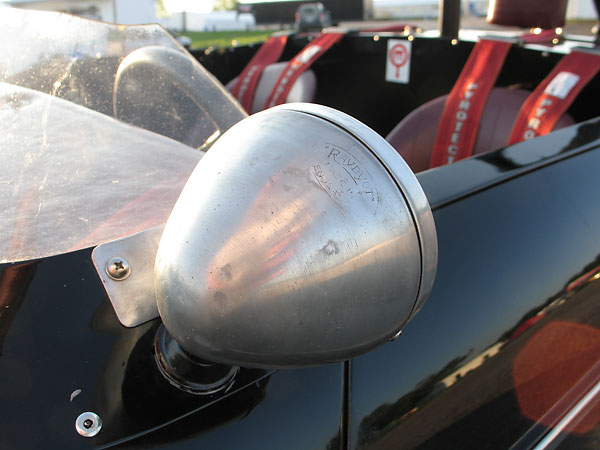
�
Raydyot (Made in England) aluminum side view mirror.
�
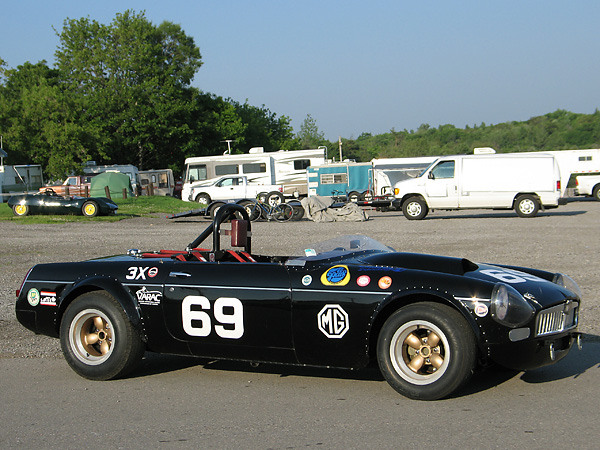
�
Both front and rear fender flares were custom formed out of aluminum sheetmetal.
�
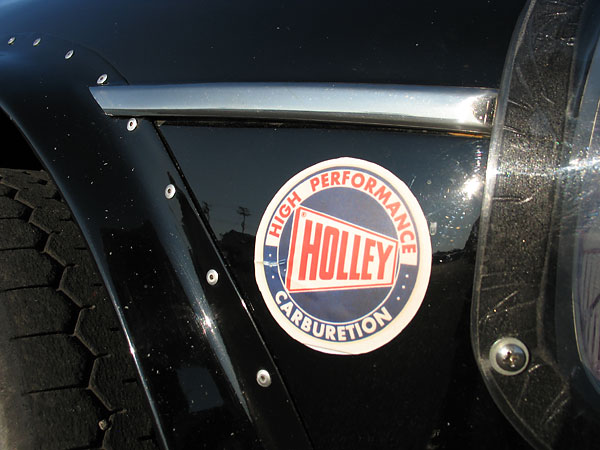
�
Holley High Performance Carburetion sticker.
�
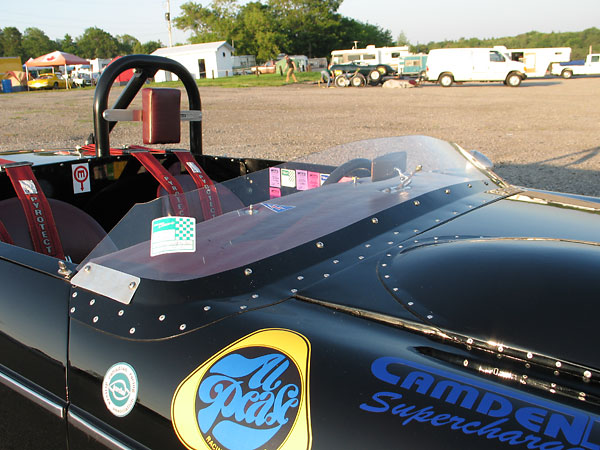
�
Molded acrylic low-profile windscreen.
�
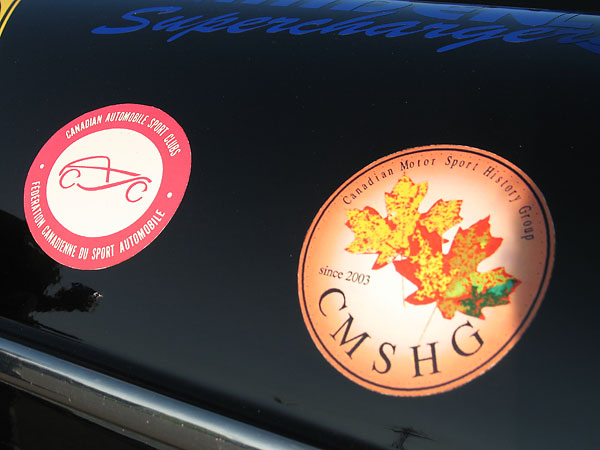
�
CASC: Canadian Automobile Sport Clubs / Federation Canadienne Du Sport Automobile sticker.
�
(CASC is the Canadian equivalent of U.S.A.'s "Sports Car Club of America".)
�
CMSHG: Canadian Motor Sport History Group (since 2003) sticker.
�
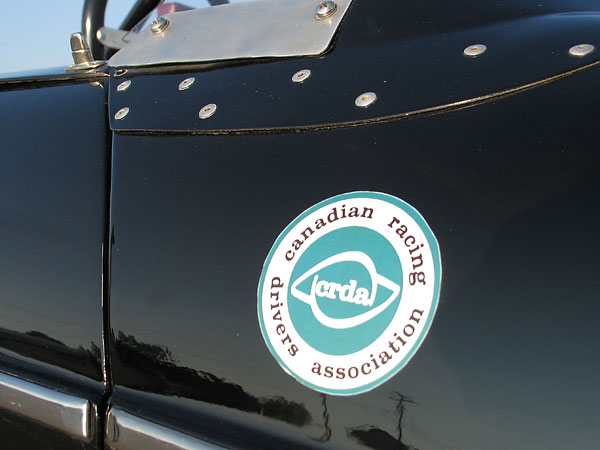
�
CRDA: Canadian Racing Drivers Association sticker.
�
(CRDA was an exclusive invitation-only club for especially successful drivers and for long-time drivers.)
�
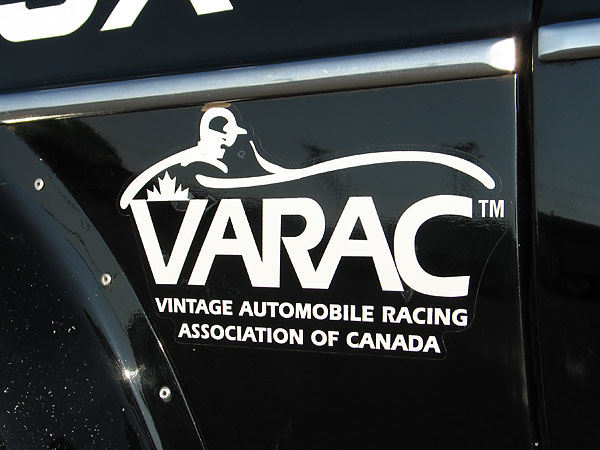
�
VARAC: Vintage Automobile Racing Association of Canada decal.
�
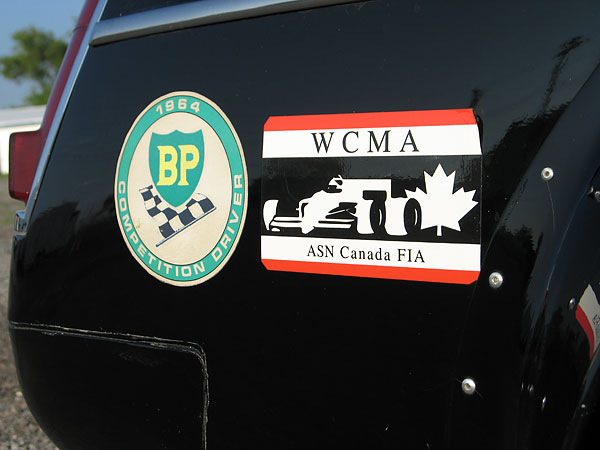
�
(left) BP 1964 Competition Driver sticker.
�
(right) Western Canada Motorsport Association sticker, an affliate regional club under ASN Canada FIA.
�
ASN: Autorité Sportive Nationale. FIA: Fédération Internationale de l'Automobile.
�
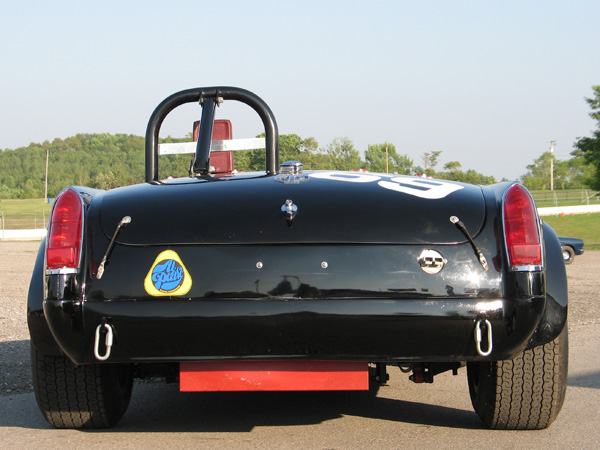
�
All of the Super-B's special body panels are aluminum except this modern fiberglas rear valance.
�
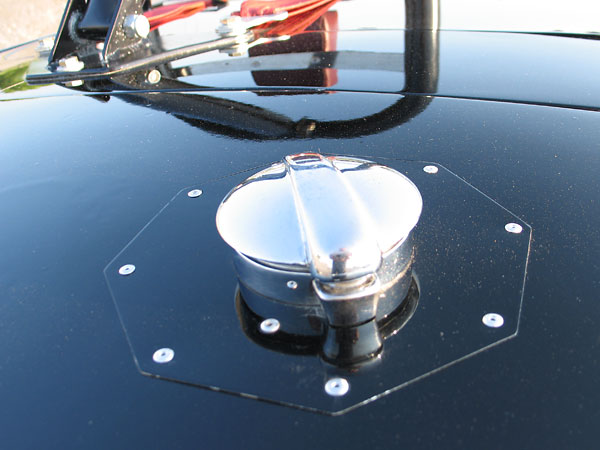
�
LeMans style fuel filler cap. (Isn't the octoganal plate a nice detail!)
�
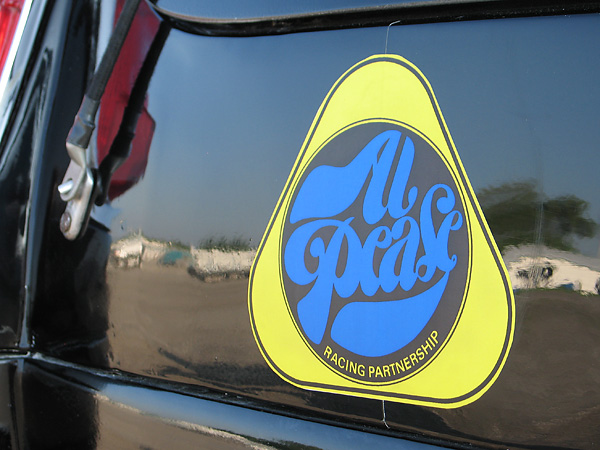
�
Al Pease Racing Partnership
�
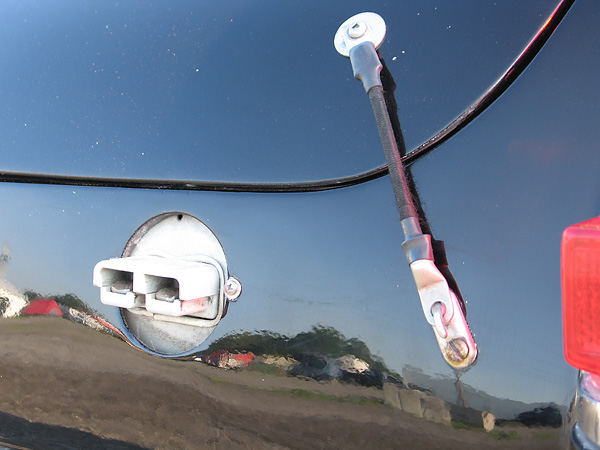
�
Battery charger connections. / Al Pease used elastic straps to hold down the boot lid.
�
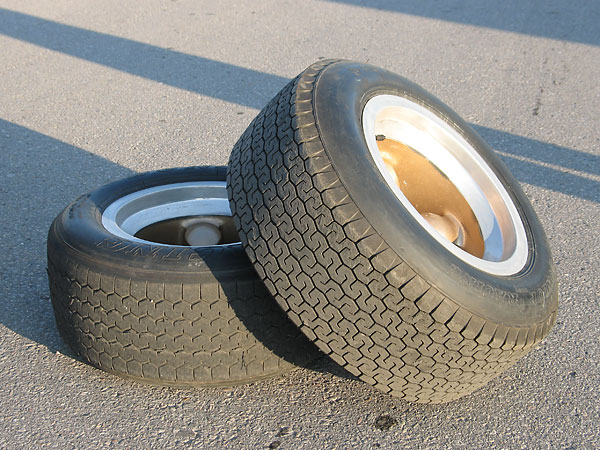
�
Dunlop Racing tires ("Formula Ford" 165/580-13 CR82 front, 5.50-M-13/CR65/204 rear).
�
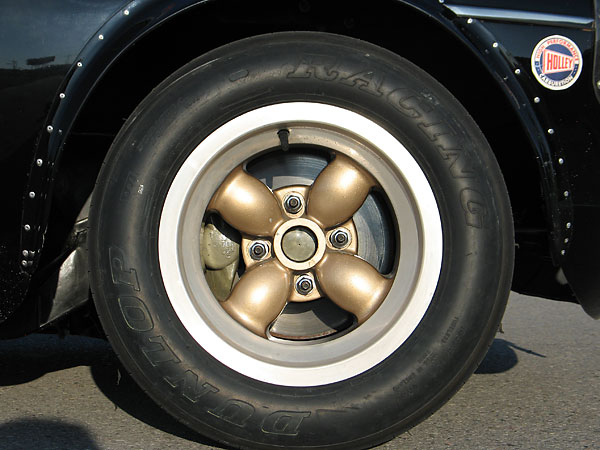
�
American Racing "Libre" aluminum wheels.
�
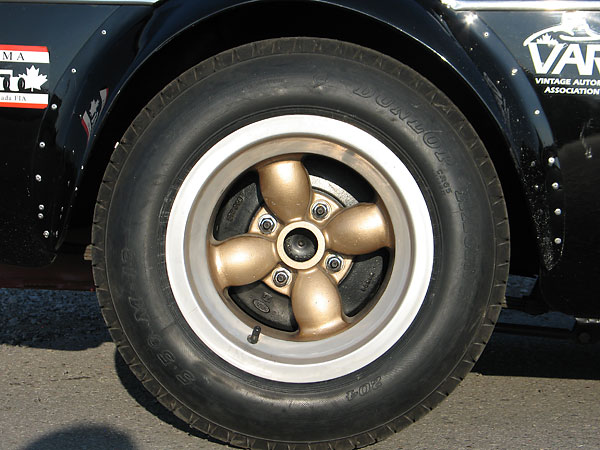
�
"CR65" is the tread pattern. "204" is the rubber compound. (It's a "dry" compound.)
�
| Notes: | |||||||
| (1) | �
Three MGBs were prepared for 1963's Sebring 12 hour endurance race, but only two actually raced.�
"6DBL" wore racing number 48 and was co-driven by Denise McCluggage (USA) and Christabel Carlisle (GB).�
"7DBL" wore racing number 47 and was co-driven by Jim Parkinson (USA) and Jack Flaherty (USA).�
According to race reports, both factory sponsored MGB's dropped out because of failed engine bearings.�
"8DBL" was taken to Sebring and driven in practice, but wasn't entered in the race.�
7DBL also raced in the 1963 24 hours of LeMans, the 1963 Tour de France car race, and was driven to GT Class victory in the 1964 Monte Carlo Rally.�
8DBL raced in the 1965 Brands Hatch 1000, and returned to Sebring in 1966 to be raced by Paddy Hopkirk and Andrew Hedges.�
� | ||||||
| (2) | �
The Al Pease Racing Partnership was a multi-car team. From 1962 through at least 1964, Al Pease�
owned and raced a Lotus 23. The MGB arrived well before the first race of the 1963 season. BMC also�
provided the team with a Mini Cooper and an Austin Healey 3000 at some point later that year.�
According to team member Bob Egginton's recollection, the Healey had previously been raced by BMC�
at Sebring, then raced for a year by Grant Clark, before being provided to the Pease team. Bob also�
recalls that the Healey came with aluminum fenders, which had to be swapped for steel before it could�
be raced within Canadian club rules. Although Al Pease drove the Mini Cooper, the Healey�
was driven by team member Don Kindree. These two cars were actively campaigned through the�
balance of 1963 and through 1964, but didn't prove quite as competitive as the MGB. The BMC sponsorship�
deal dissolved after 1964, and Al Pease bought all three cars for one Canadian dollar. He kept and�
continued to race the MGB for two more seasons, but he sold the Mini and the Healey. Some records�
indicate that Pease raced an Alfa Romeo TZ-1 and also an Austin 1800 rally car in this period,�
but specific details aren't known and are well beyond the scope of this article.�
� | ||||||
| (3) | �
BMC Competitions Department MGB racecars used single Weber DCOE (dual venturi) carburetors in lieu of�
dual S.U. (single venturi) carburetors on at least one occasion.�
� | ||||||
�
Seven vintage photos were provided for this article by Mike Adams. (Original photographers unknown.)�
Mike Adams' pre-restoration photo of the Super-B is used by express permission, as are his six photos�
of restoration details. Web-optimized digital versions of these fourteen photos are copyright 2010,�
by BritishRaceCar.com. All rights reserved. All other photos shown here are from June 2010 when we viewed�
the car at VARAC's 31st Intl. Vintage Racing Festival at Mosport Motorsports Park, in Ontario Canada.�
Photos by Curtis Jacobson for BritishRaceCar.com, copyright 2010. All rights reserved.
�
| If you liked this article, you'll probably also enjoy these: | �|||||
 | �
Michael Zappa 1962 MG MGB | �
 | �
Marcus Jones 1964 MG MGB | �
 | �
Alan Tosler 1964 MG MGB | �
�
| You're invited to discuss anything you've seen here on The British Racecar Motorsports Forum! | �|||||
�
Notice: all the articles and almost all the photos on BritishRacecar.com are by Curtis Jacobson.
�
(Photos that aren't by Curtis are explicitly credited.) Reproduction without prior written permission is prohibited.
�
Contact us to purchase images or reproduction permission. Higher resolution images are optionally available.
�

 �
�
 �
�